Herzstark Multimator
A machine which at first sight looks like a relatively uninteresting Astra adding/listing machine with a wide carriage, turns out to be on second consideration something entirely different.
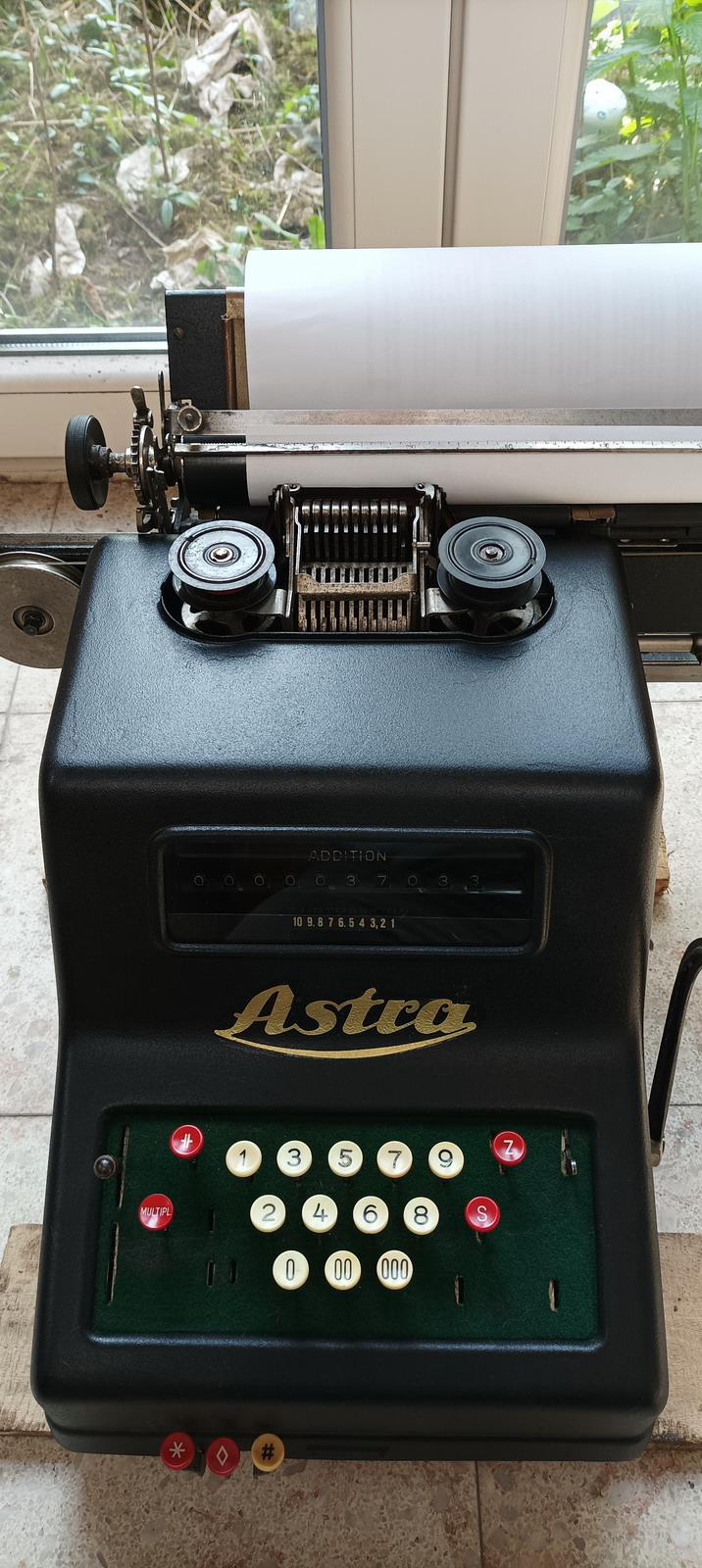
Curt Herzstark, son of Samuel Herzstark, owner of the Austria calculator factory in Vienna, and he himself inventor of the smallest mechanical pocket calculator, the Curta, decided at the end of the 1920s to develop the Astra listing machine into a complete bookkeeping machine that could add several columns separately. This was after talking to the new manager of a hat factory in Neutitschein (Novy Jicin), the Hückel factory (they still exist today, by the way!). They had a Remington bookkeeping machine on trial, but it turned out that with a wide carriage Astra, time studies indicated that adding columns was 40-60% faster. The manager told Herzstark that it would be even better if it could also add the column totals automatically, without having to read and reenter the numbers. And this, young Herzstark took as a challenge, and swiftly developed the 10-key bookkeeping machine that is the Multimator. He made the invention in 1928, his father patented it on Feb 2nd 1928 as patent AT129584, and about 350-400 of them were built between 1928 and 1936. This is in fact one of them.
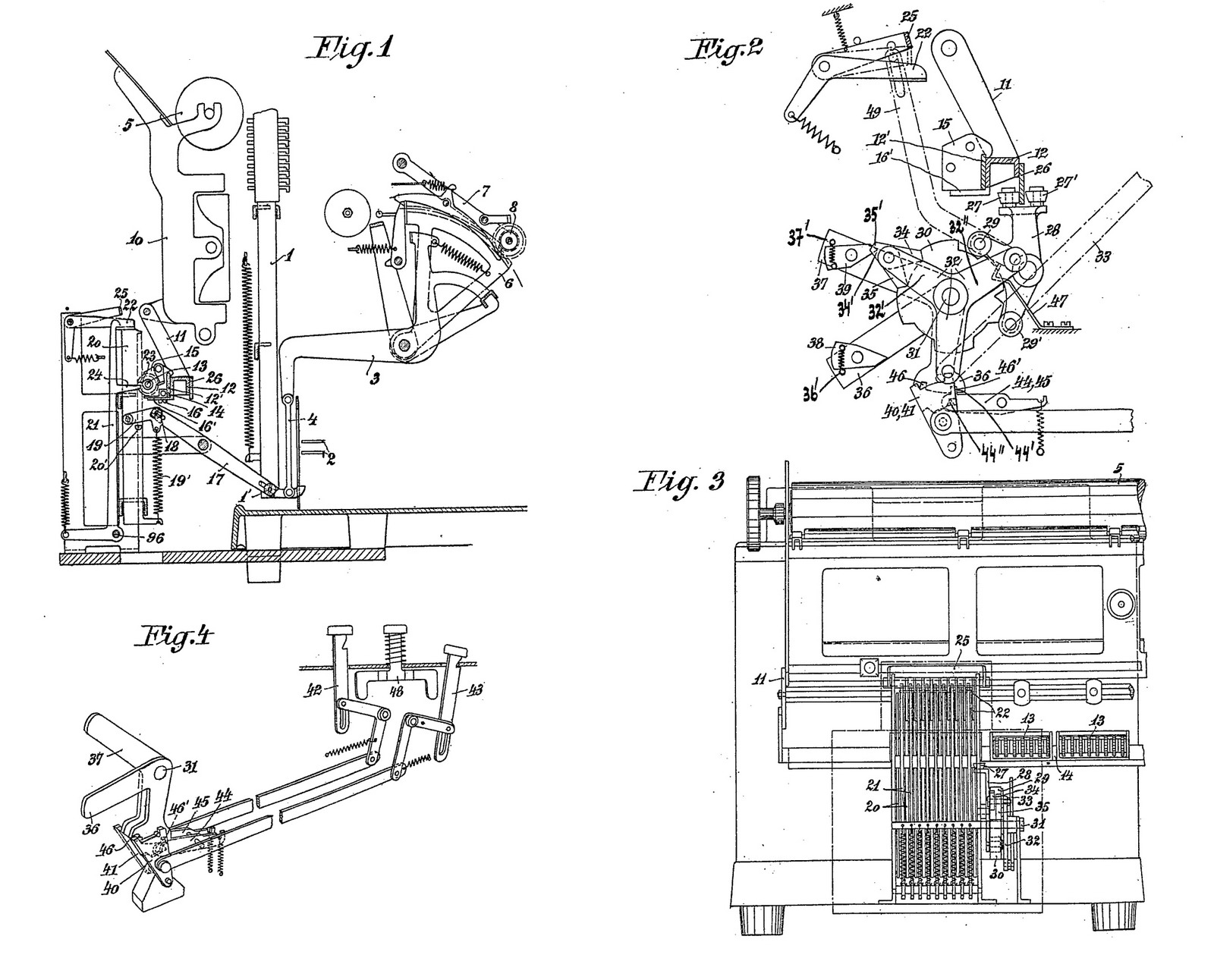
In Herzstark’s own words, “this was a standard machine that we obtained from the factory and onto which we built a second calculator backwards onto the machine. This carries over exactly the same numbers as the front calculator. And here on the carriage we put as many counters as there are columns, so when the carriages moves, the individual results are stored here completely automatically. And when you were finished, you could print at any time in the same way... there were three keys, the total, subtotal and number. At the end of a page you could print the subtotal and the machine ran through and printed all of the sums, and the subtotal would carry over automatically without having to read off the result. The machine did this, and one could carry on. And when you printed the total, the machine cleared itself. That was my first invention.” (From Tomash’ interview with Herzstark, 1987)
And indeed, this is exactly how it works. There is a small cube-shaped aluminium cast housing on the back of the machine, which contains the “Multimator”.
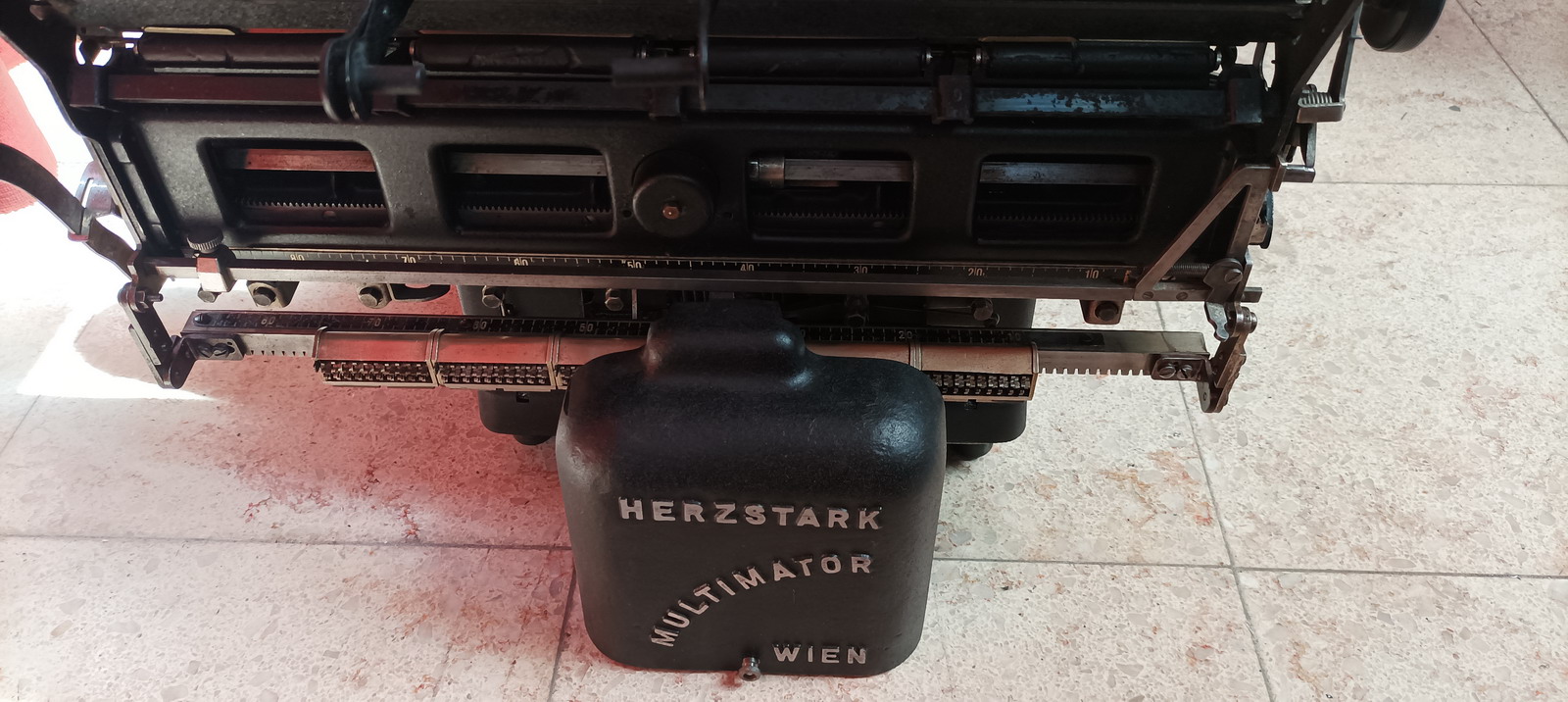
The extra memory registers sit on a rail at the bottom of the (wide) carriage and tab stops are installed on the carriage so that the machine stops at the correct column for bringing the respective memory in conjunction with the Multimator.
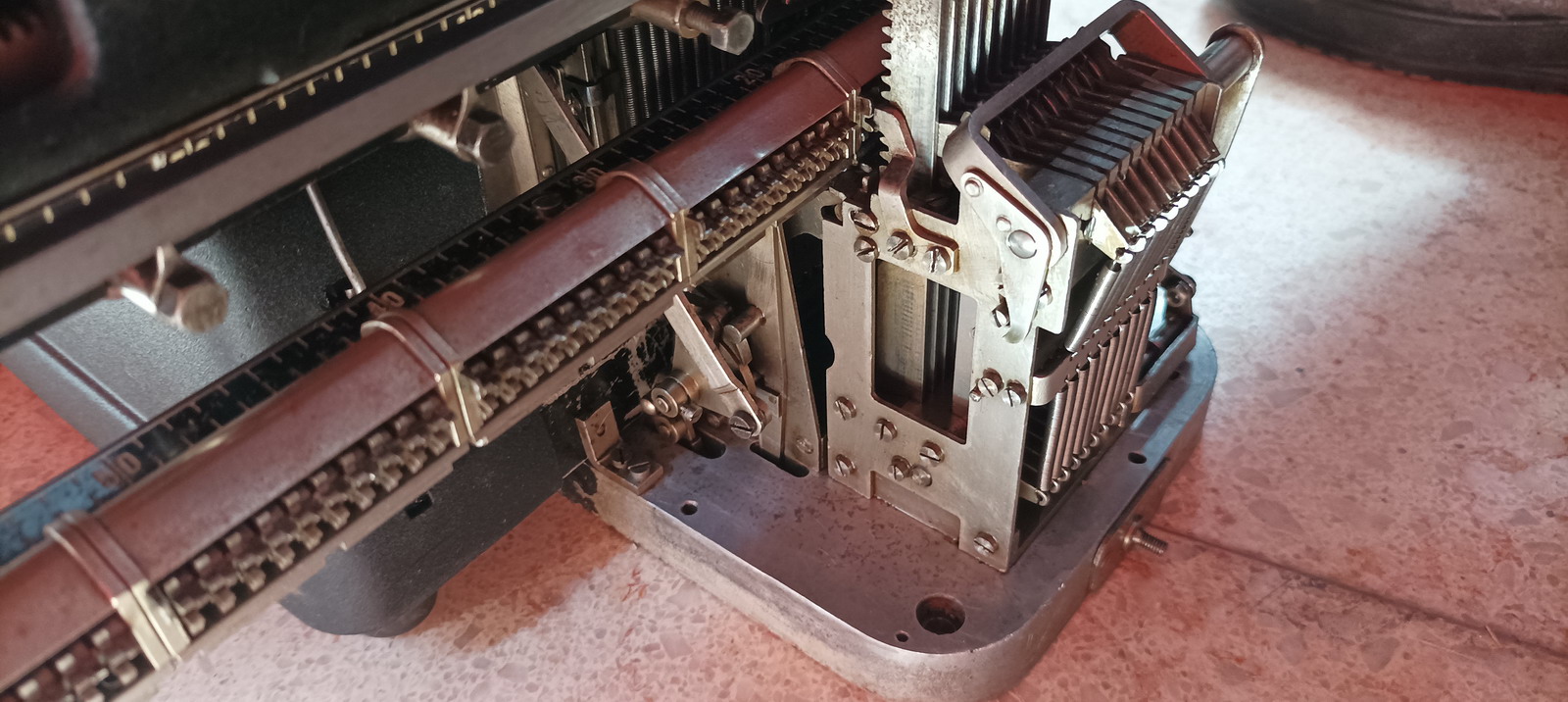
The bars of the Multimator machine are in direct connection with the printer bars of the Astra - so when pulling the handle, racks in the Multimator move downwards the amount corresponding to the number being printed, and when the handle is fully forward, the active memory register is engaged and on the upstroke of the racks, the number is entered into this memory register. The registers have a tens carry tooth for every gear - this tooth, on passing from 9 to 0, unlocks a stop in the Multimator, which lets the next gear rack click into a position one step higher than normal, hence providing a tens carry to the next gear.
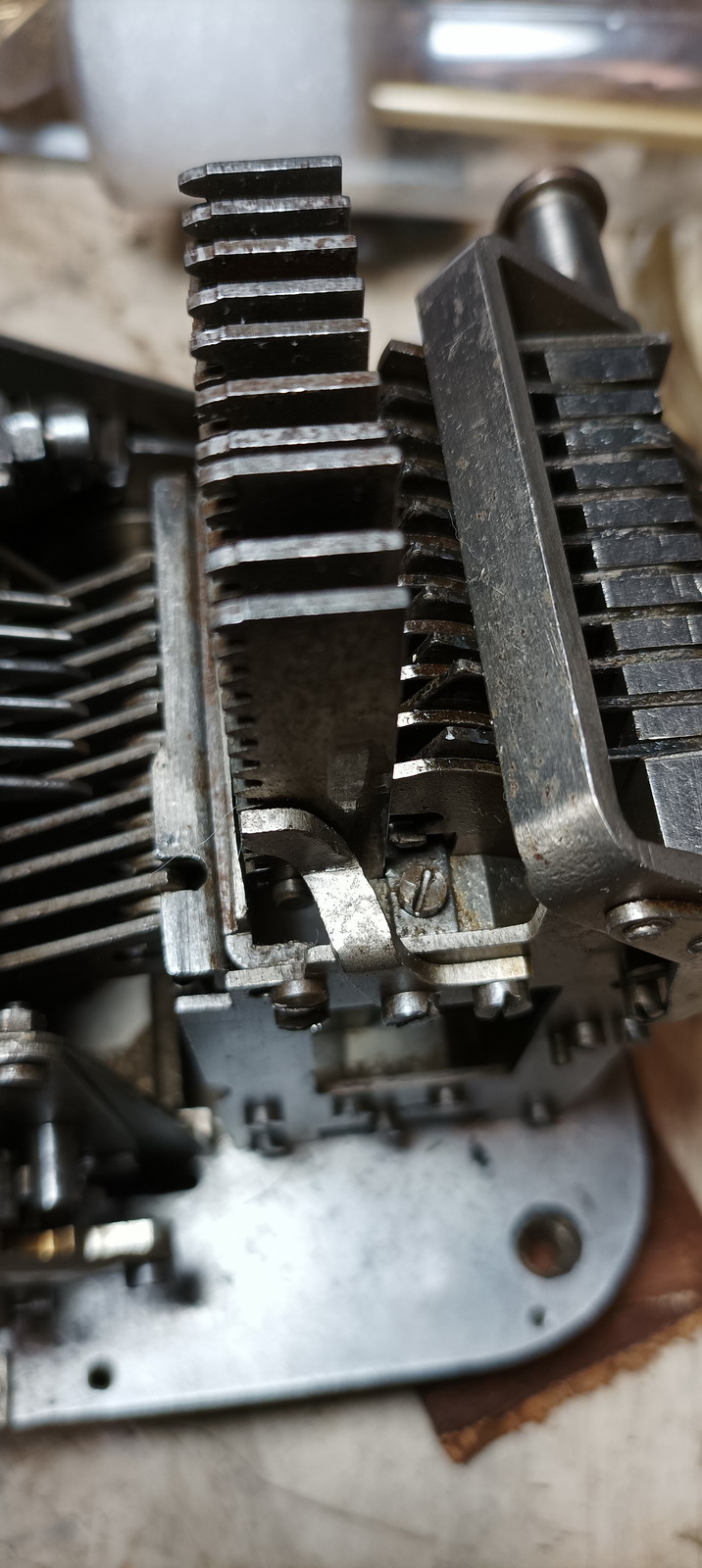
The Astra has a “non-add” setting that can be used in conjunction with the Multimator, but not in the way that would seem obvious ... The thing is, everything that shows on the printing bars gets added in the active register of the Multimator. The Multimator doesn’t do corrections or subtractions either. So pressing the non-add key on the Astra will not affect the Multimator, it will keep adding happily.
What it will prevent is that the numbers being added into the Multimator also go into the main (display) register of the Astra.
If the Astra is set to subtract, it will print in red and subtract the numbers from the values in its main register - but the Multimator will happily keep adding those numbers in the active rear register, instead of subtracting them.
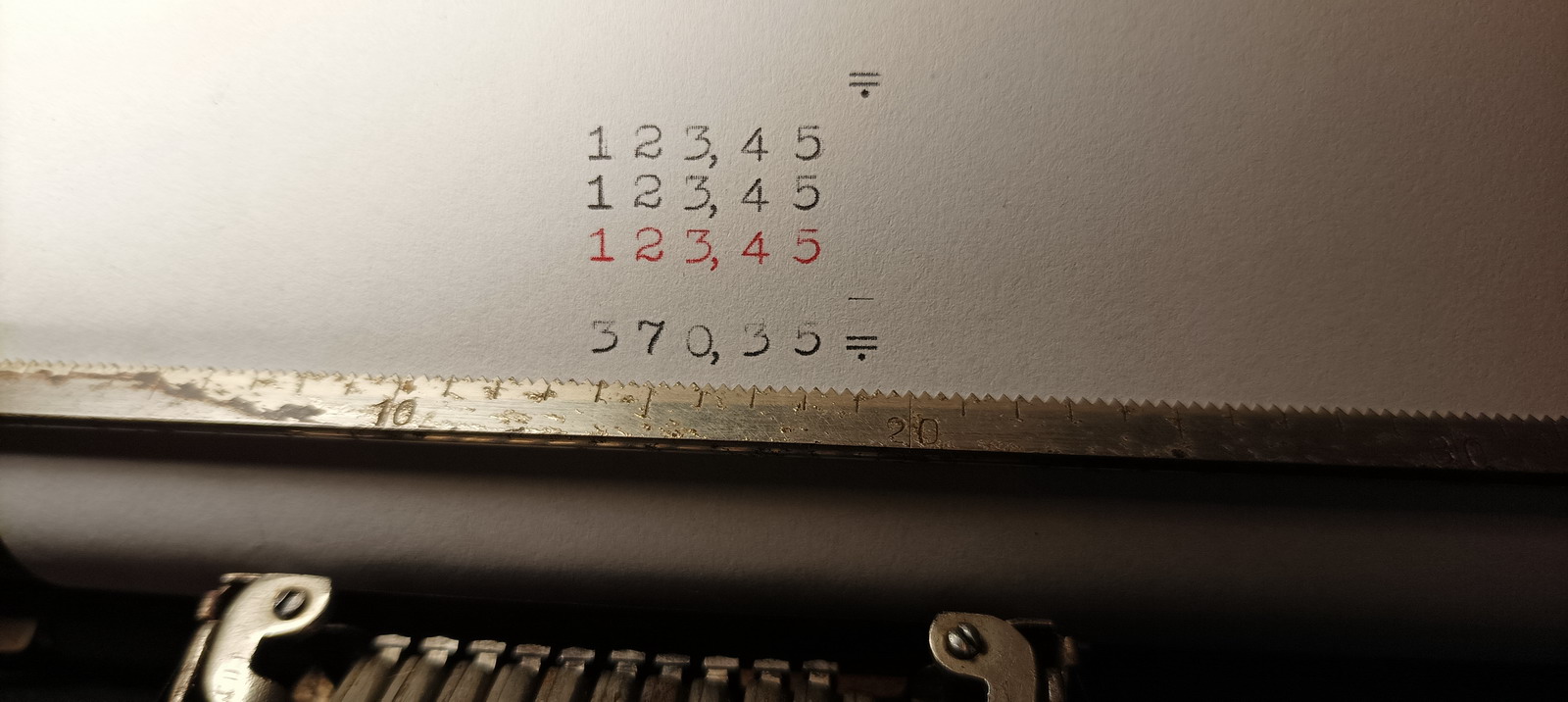
Subtraction in the Astra happens by tilting the main register, so a different set of intermediate gears is in contact with the register gears.
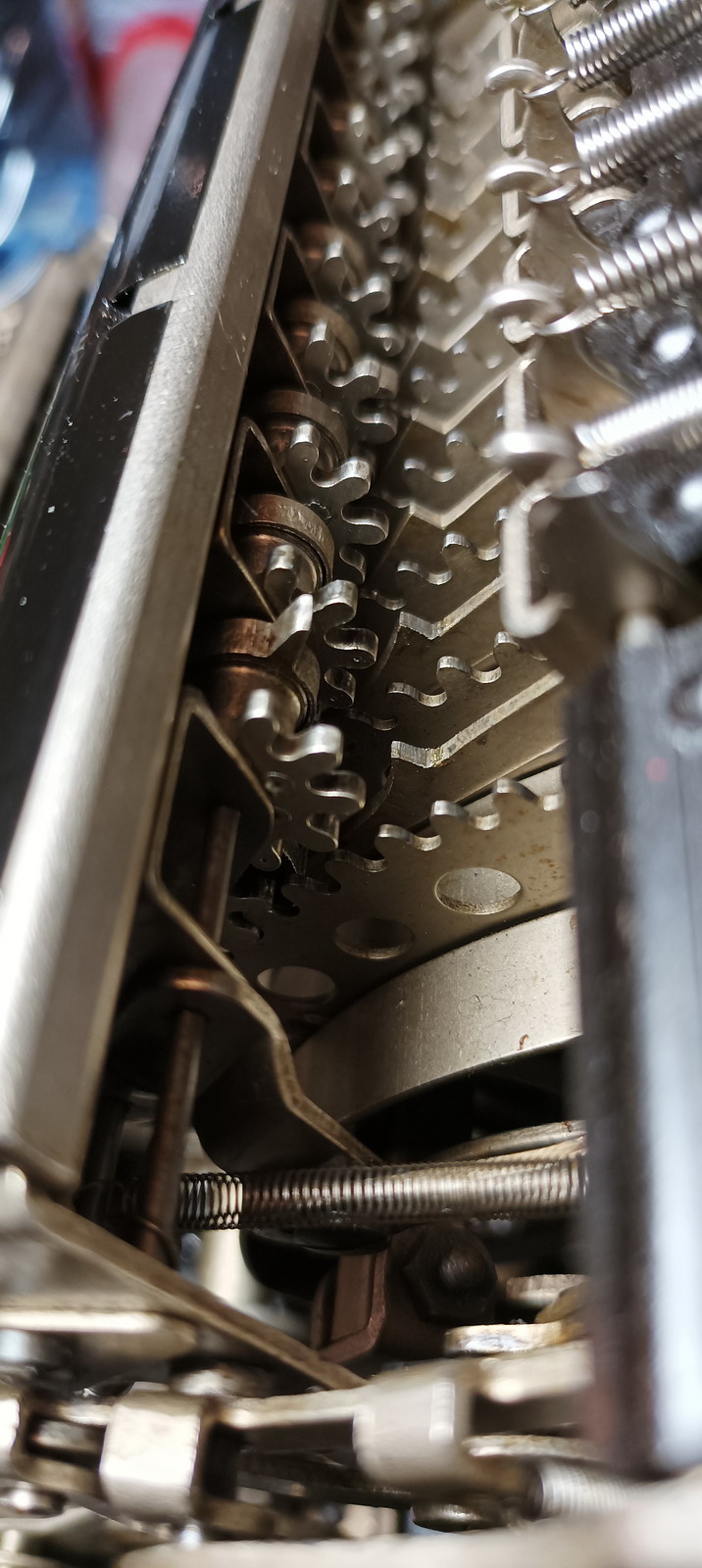
As mentioned already by Herzstark himself, the Multimator only had three keys, that were added to the front of the Astra machine - “Total”, the *-key, which then controls the print bars and main register of the Astra from the Multimator, and simply reads out the value in the active register, transferring it to the print bars and main register, then disconnects the register once it is read out to zero, thus clearing it. It prints an = sign with a dot under it on the printout.
The second key does the exact same thing, but reads the number extracted from the memory register back into it after it has been read out - this is the “Subtotal” key, with the diamond on it - it prints a diamond with a dot under it, to distinguish it from the Subtotal from the main register.
The final key is the white hashkey, which does a “non-add” to the Multimator - what is printed (and added to the main register if the non add key of the Astra is not also pressed) in the Astra will not be added to the active register in the back if this key is pressed. It doesn’t print anything.
So this allows to see how the machine can be used - with the automatic tabulation and line feed of the Astra, either the machine adds one column at a time, or you can work horizontally across the page, adding horizontal entries to subsequent columns.
Some experimentation suggests that it may be best to keep the non-add key of the Astra engaged, so that the numbers entered go straight to the respective back registers, and not (also) into the main register of the machine, because otherwise things can get awfully confusing ... The disadvantage is that the Astra non-add key unlocks after every stroke of the crank - so it needs to be either pressed every time, or held down.
Per column now (sub)totals can be made, that can be made to go into the main register of the machine to get a (partial) cross-total by not pressing the Astra non-add key while taking and printing the column (Sub)totals. If the non-add key is engaged, the subtotals do get printed (e.g. at the end of a page), but not added to the Astra main register. If the cross-total accumulated in the Astra register then has to be printed, at that point in time you have to make sure that either the carriage is in a position where there is no active register enagged with the Multimator, or alternatively, the Multimator “non-add” key is pressed, if not the printed total will (also) go into the currently active register of the Multimator.
Alternatively, one can not bother with the Astra non-add key when adding numbers in columns, and the main register of the Astra will simply accumulate the grand total. Subtotals at the foot of a column can then be printed by pressing the Astra “non-add” key and the multimator total key. The grand total from the main register gets printed first by pushing “S” and the Multimator non-add key, then the subtotals can be added into the main register as before, and then finally printing the value there again will provide a cross-check and proof. If a column total needs to be subtracted, this can only be done in the Astra Main register - in that case, when totaling the column, the machine needs to be switched to subtract, and the number will be printed in red and subtracted for the cross-total.

This is an example of a payroll with the Astra, with horizontal totals - every line is a wage, with columns for gross wage, overtime, postage (-), health care (-), insurance (-), and net wage. The multimator keeps the total of every column, including the net wage, and can print them all at the bottom of the page, so the total for e.g. insurance is known and can be paid to the insurance company.

In order to correct a wrongly entered number, the procedure must involve the main register of the Astra. There will of course be a printed record on paper of the wrongly entered number in the Multimator. If you have a leftover register, tab there and totalize, so the current total goes into the empty spare register. The go back to the column with the error. Totalize that column, so its value goes into the main register and it gets cleared. Press the Multimator non-add, switch the Astra to subtract, and subtract the wrong number from the main register. Now press the MM non-add key again and add in the correct number to the main register. Now totalize the main register, which puts the number back into the MM and empties the Astra main register. If you want, you can now tab over to the spare register and pick up the provisional grand total you stored there (to which the same correction still needs to be made!). Then carry on as you were ... Alternatively, at the end of the whole addition exercise gone wrong, clear the Astra main register (which now only contains a partial total after the correction), and totalize the column footings from the rear registers for a grand total.
Now, some peculiarities of the Astra itself - it has two tiny levers next to the printing bars - the left one will engage “tab-after-print” and is very useful for several-column addition. The one on the right will prevent the printing hammers from reaching the printing bars, and hence gives “non-print” functionality. There is a correction lever at the left of the keyboard, that when pressed up will erase the last typed digit, or when pressed down will erase the full set-up reegister. There is a multiplication key, which when pressed will prevent the set-up register from being cleared on operation of the crank, and there is the non-add key, which will allow a number to be printed but not added to the main register of the machine (it will get added to the Multimator though ...). Then there are the numeral keys, including 0, 00 and 000, a Z key for “Zwischensumme” (subtotals) and an S key for “Summe” or Total. This S key can only be pressed after cranking once with the setup register empty. There a small lever at the right that can be used to switch the main register to subtraction. Line feed is engaged by flipping a switch at the back of the carriage, and then on the left side of the carriage there is a pointer that can be set to feed 0, 1, 2 or 3 lines.
Now, when the machine arrived here, the main issue was that it keyboard was filthy - I initially though this was smoke- or nicotine induced, or perhaps discoloration from glue - but when the discoloration laughed at me when bathed in dilute hydrogen peroxide, it became clear that it was really rust that was infused in the keytops.
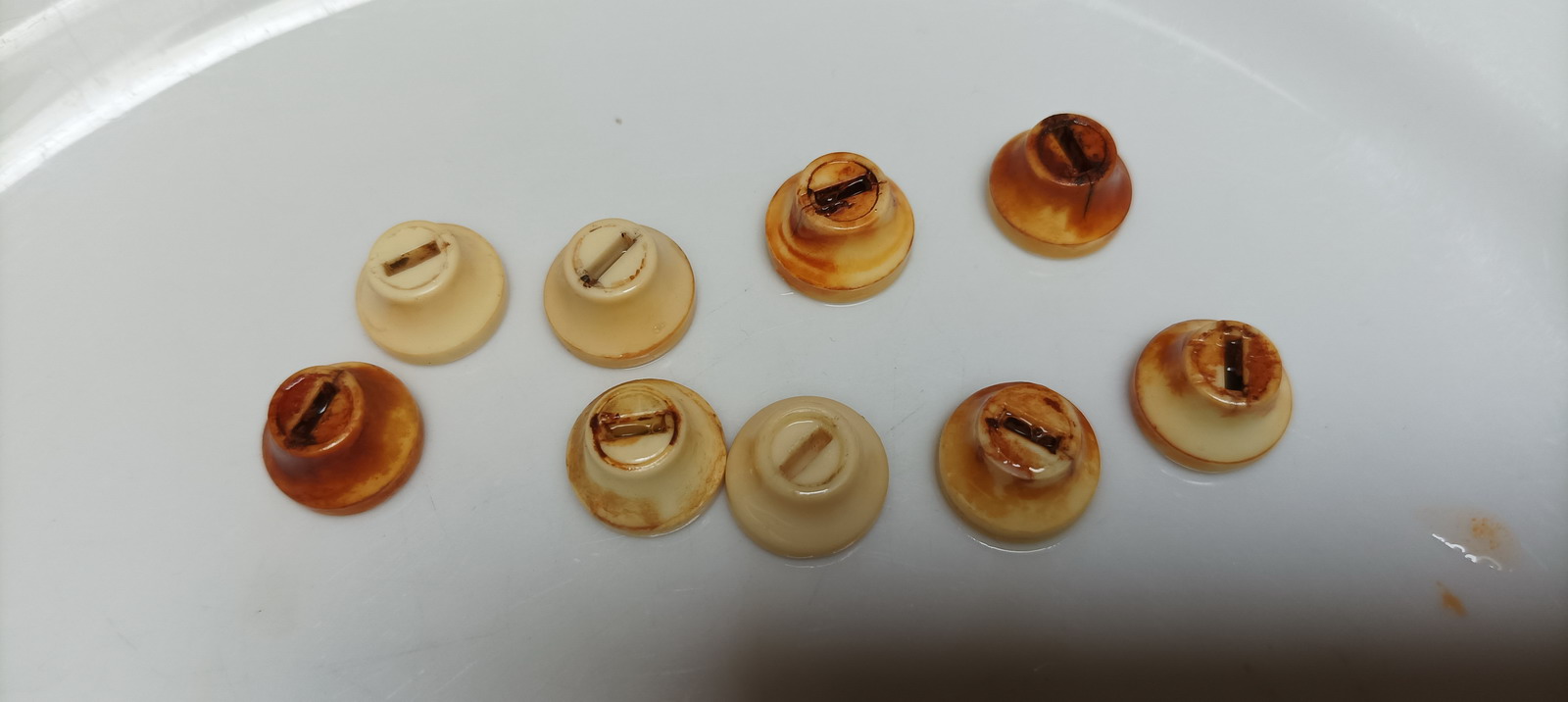
No wonder, looking at the keystems...
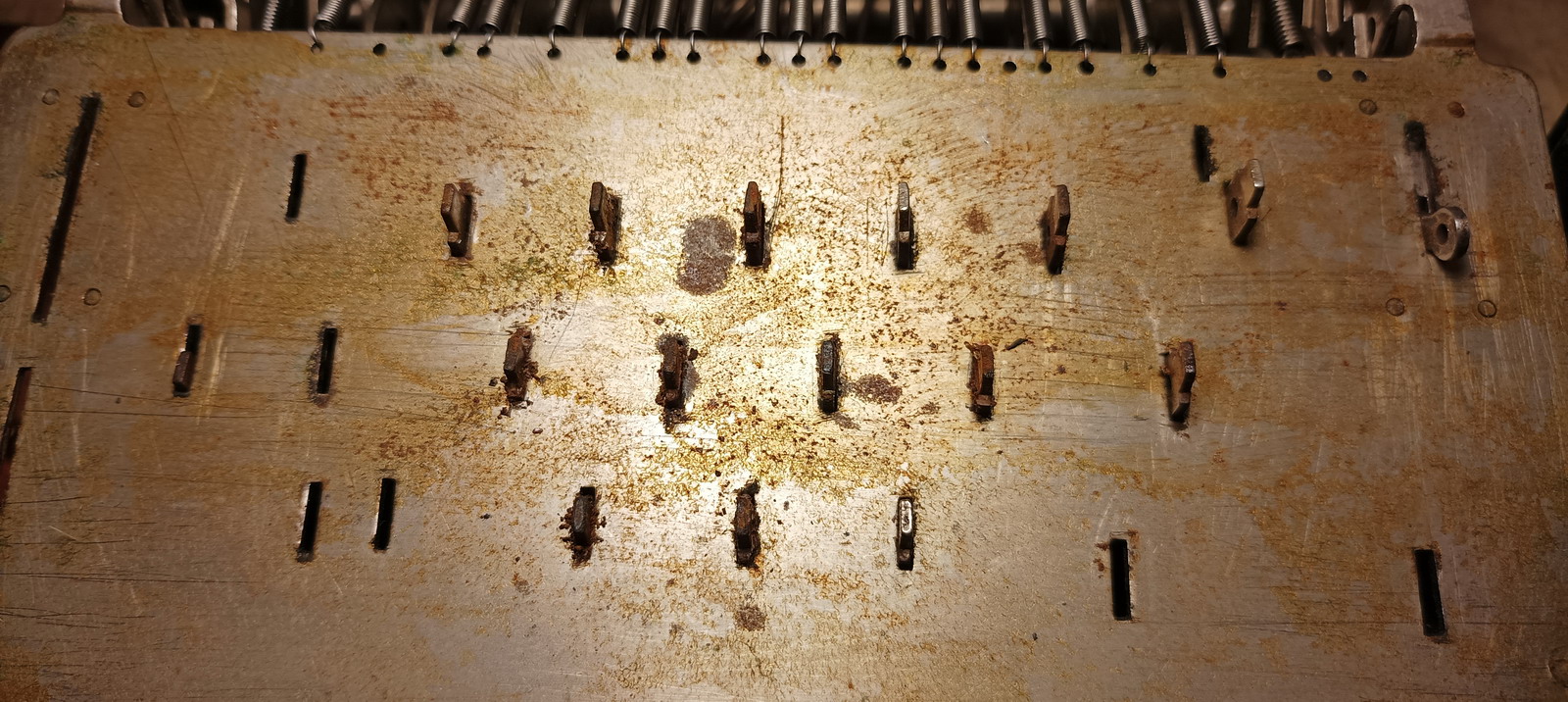
Now, those were cleaned up quickly ... before:
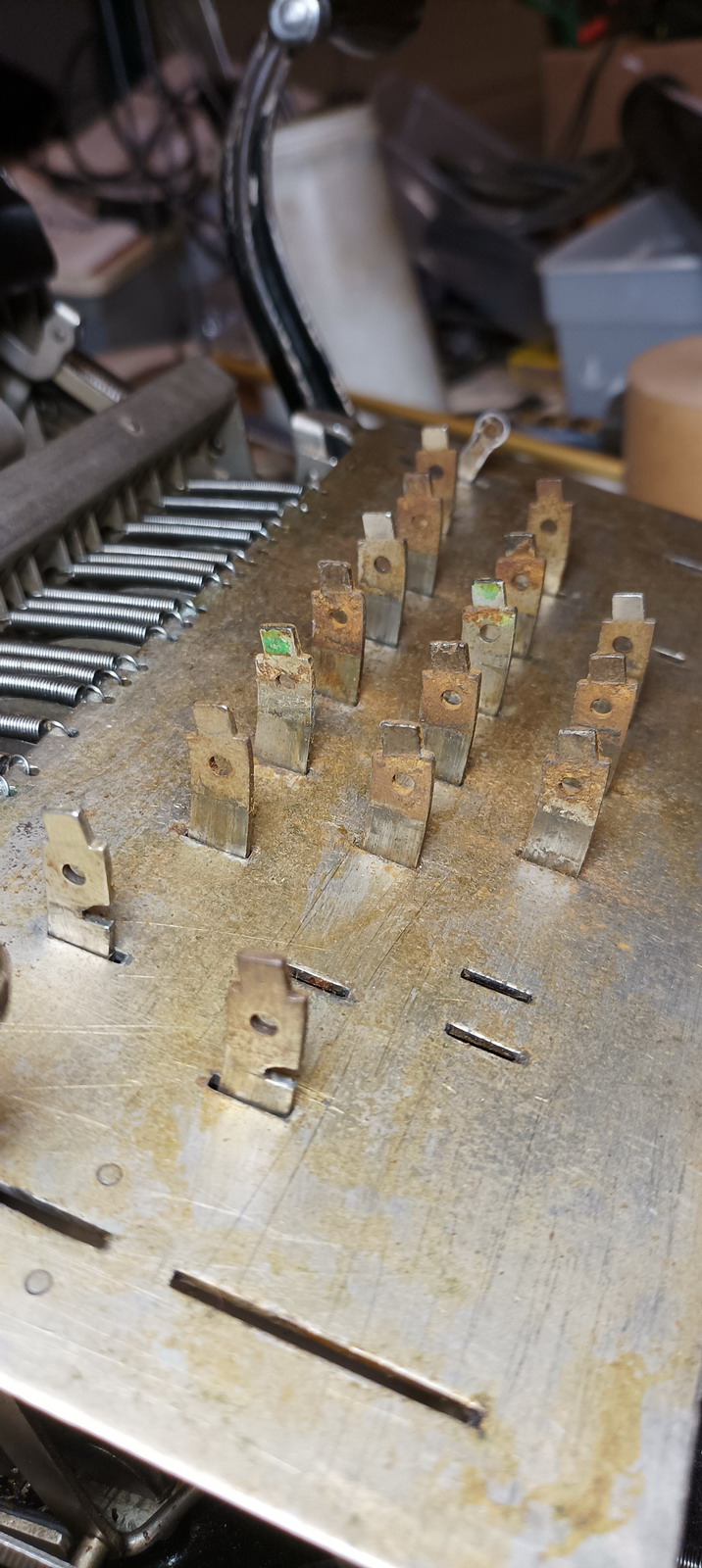
And after:
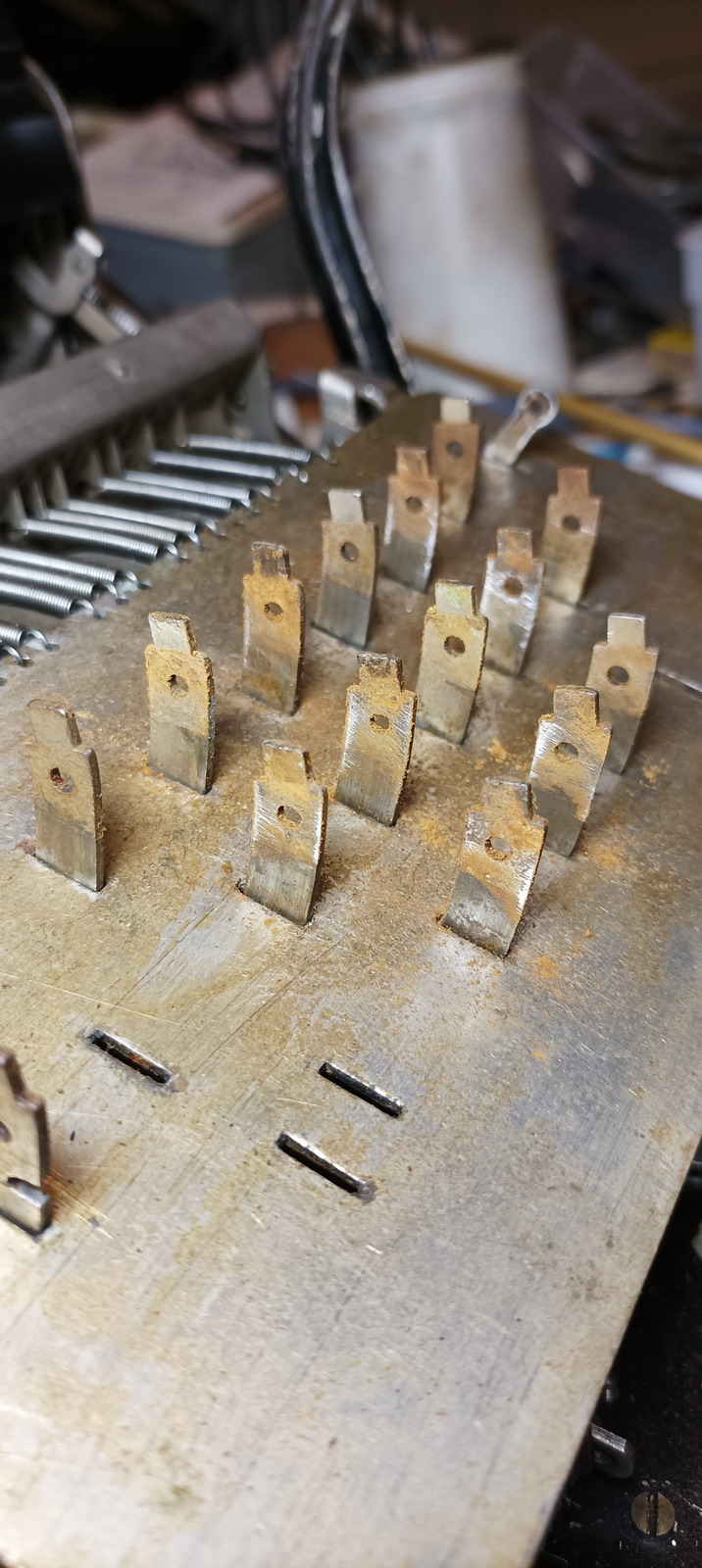
The green felt was also given a bath to wash out the grime. For rusty keytops, I have another chemical in my arsenal that nicely complexes Fe2+ - oxalic acid. The keys were given a two hour bath in it, and would you look at that!
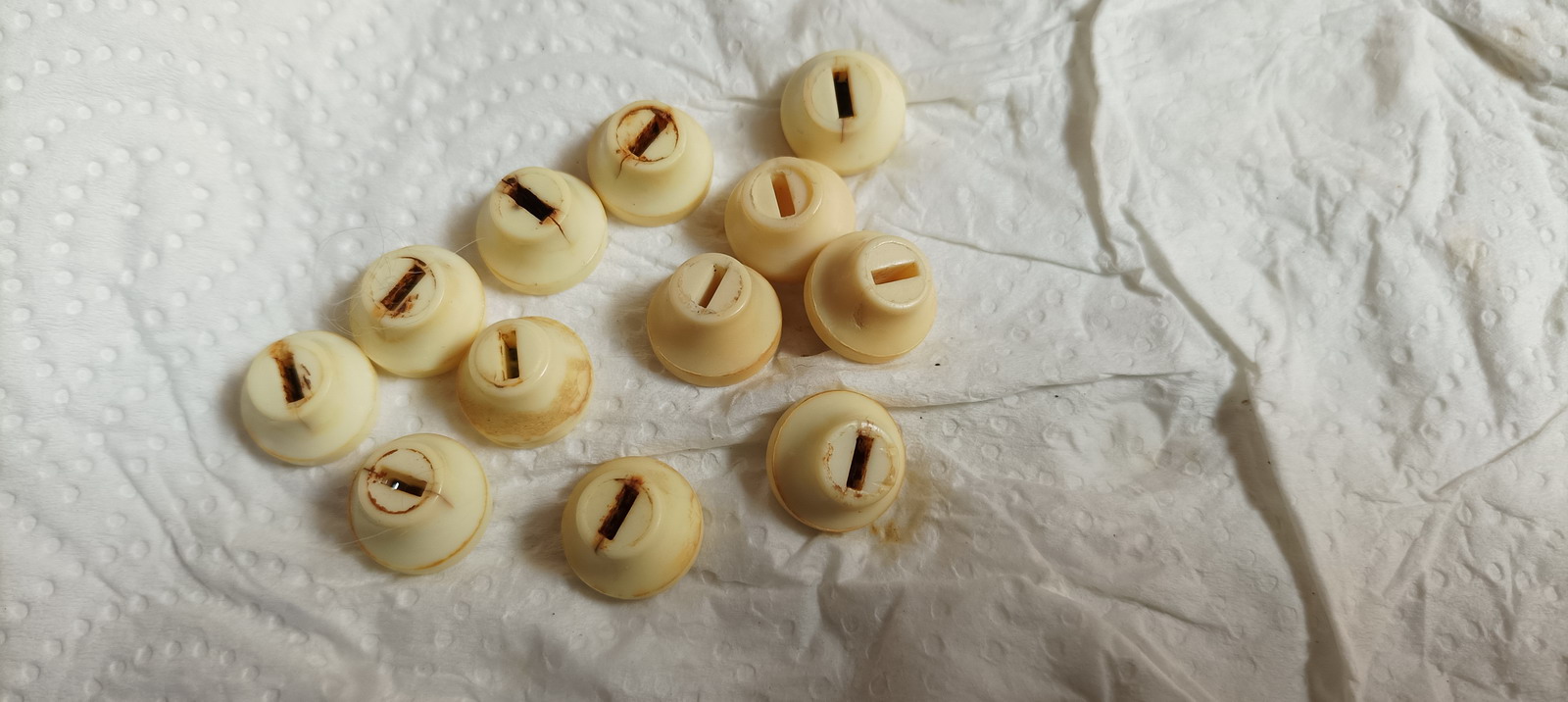
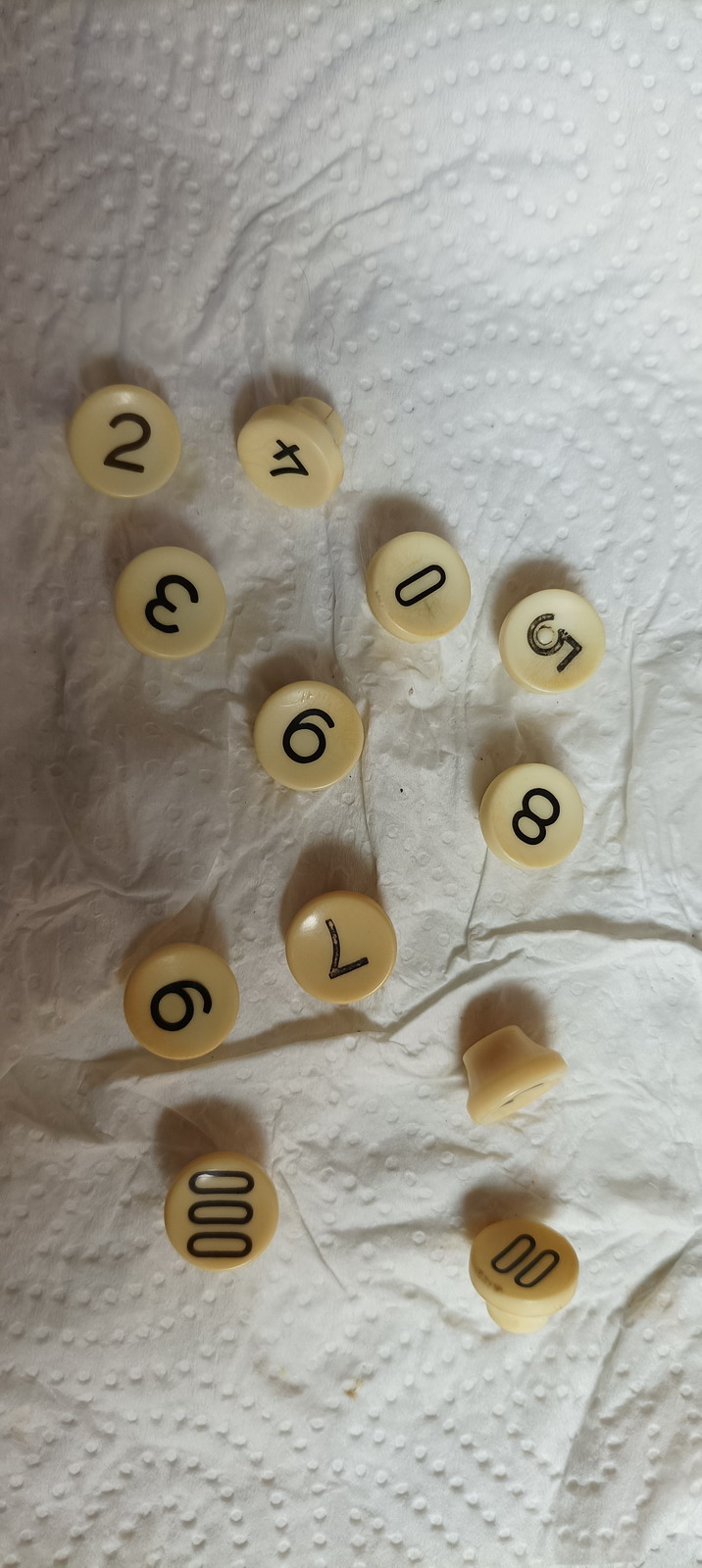
I initially thought that half of the keys were missing, but this is just a weird quirk of the Astra Werke - they would use the same keyplate and felt for every machine model, so the keyboard has slits provided for the selection levers and keys for the Astra D, with two result registers, as well as the button for motor operation. Seriously, how hard can it be to provide a piece of felt without these holes ? But nothing is missing, apart perhaps from the tiny screw-on knob on the +/- selection lever.
After I blocked the machine, I discovered that in order to take the cover off, the carriage needs to be removed. I had a devil of a time trying to accomplish this, in the end really only two screws, and two linkages at the bottom of the carriage that lead into the machine need to actually be removed, but 20 screws onwards, when this finally started dawning on me, it was already too late. It then transpired that the correct function of the registers at the back is very sensitive to the precise adjustment of the position of the carriage - oh deary me. After wrestling the cover off, and unblocking the machine, and putting everything back together, some experimentation ensued... but luckily I managed to get everything operational again.
To show for my efforts, here’s a picture of the setup register - at least I could photograph that!
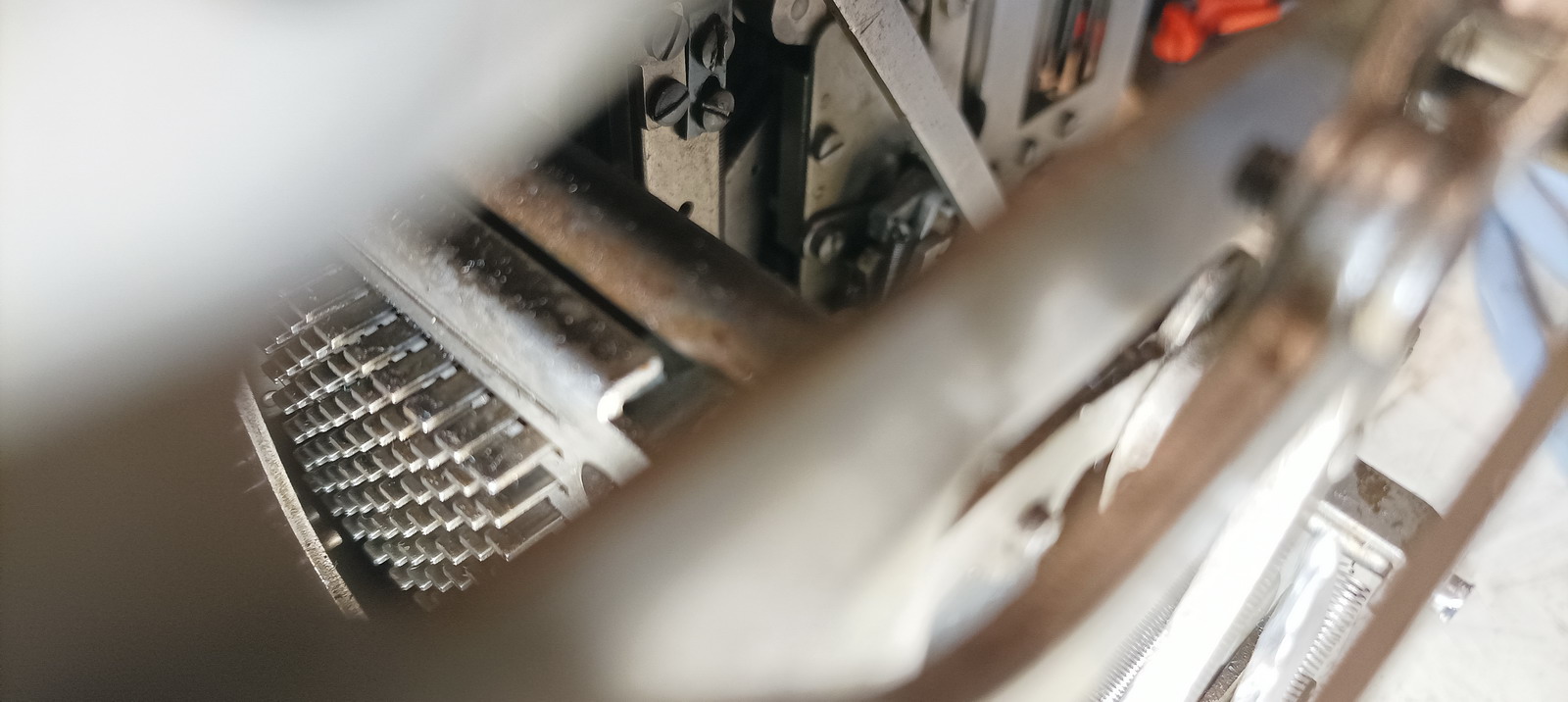
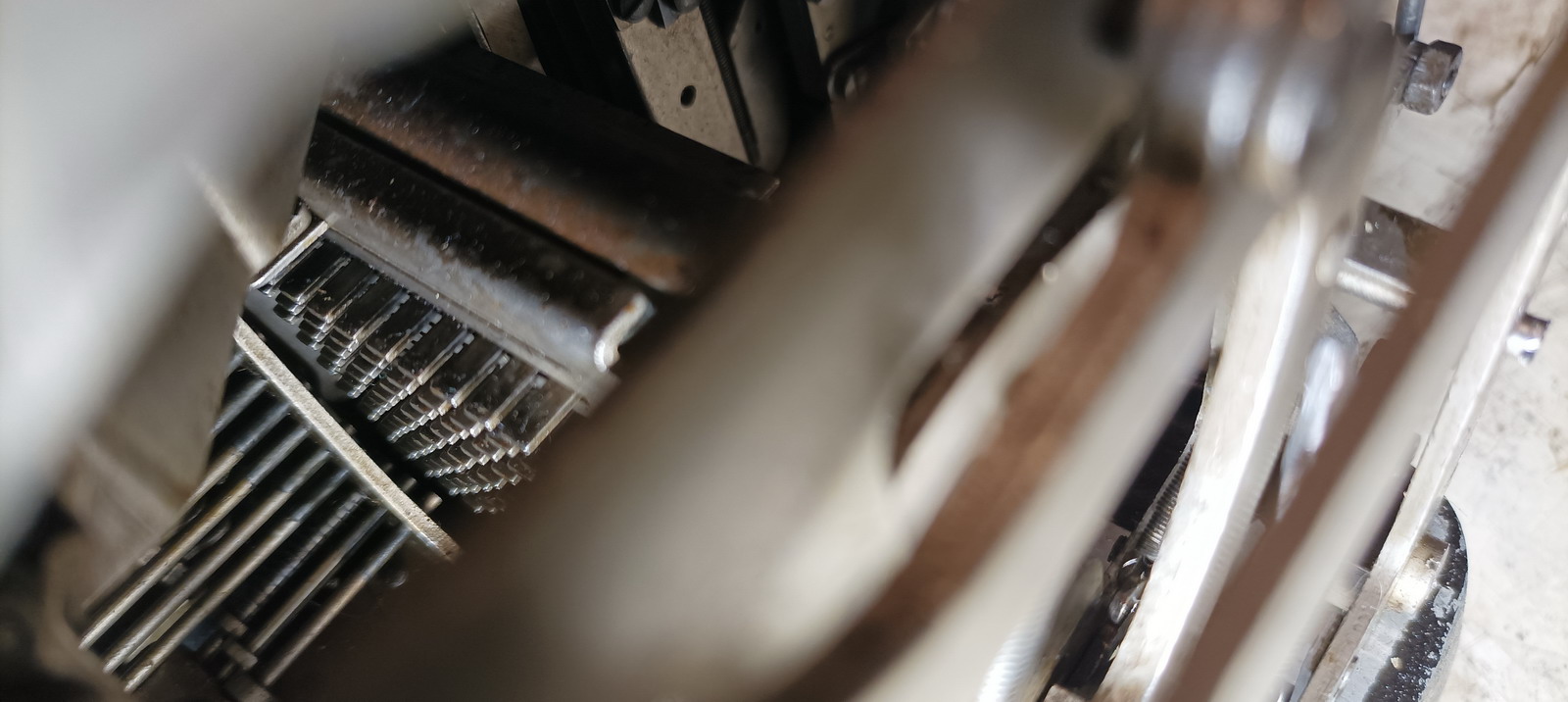
There was one weird phenomenon remaining, which happens on operating the Astra non-add key. This will for about half the time mistakenly print the symbol for the “Multimator total”, which is the symbol one step lower on the printing bar. Related to that, the Subtotal key does not print its diamond symbol, but the “non-add” symbol instead. So that took some more digging. It turns out that the final print bar with the symbols is controlled by this stepped sector over here:
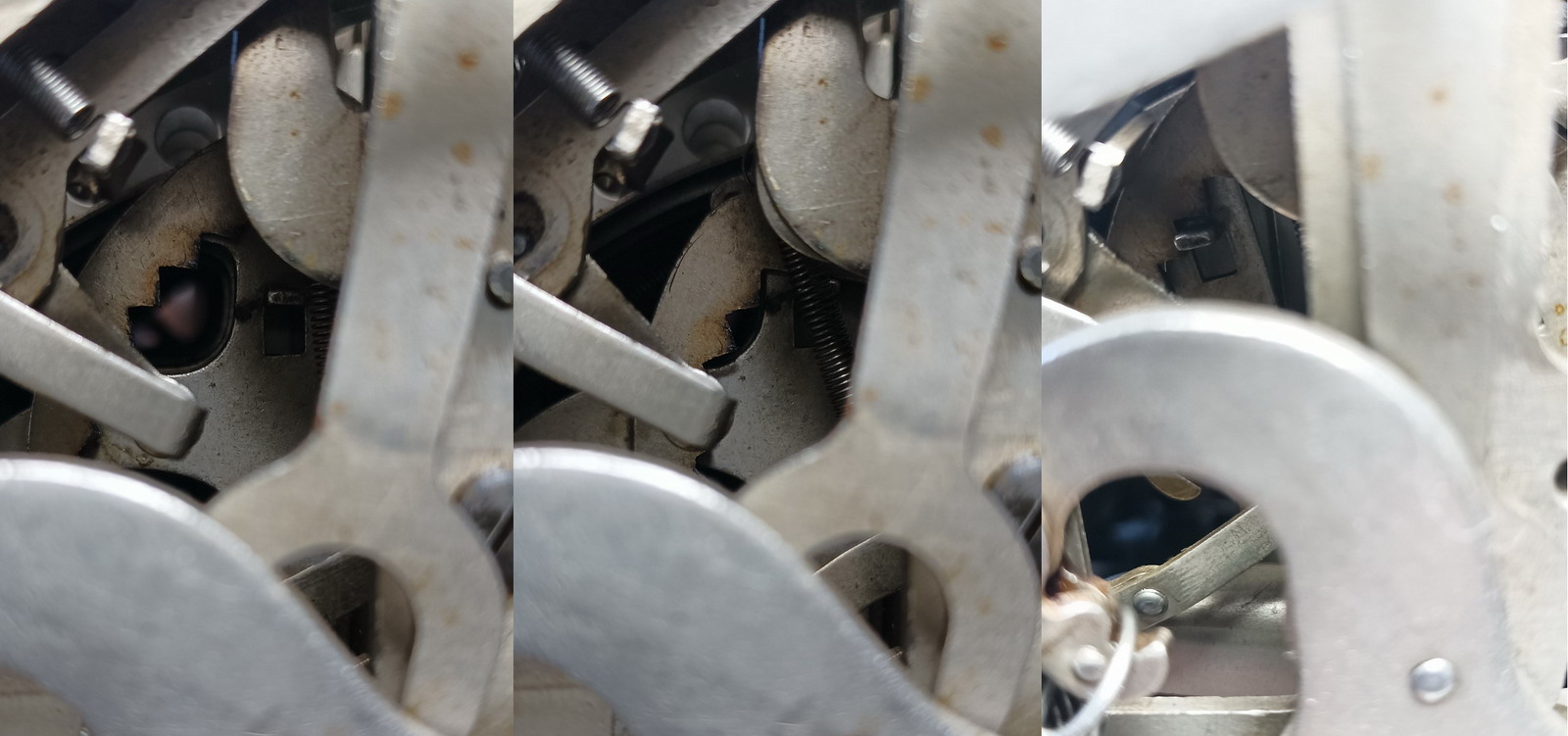
You can see in the leftmost two images how the sector moves when various keys are pressed.
On operating the machine, the lever with the pin comes forward until it is stopped by the sector, and the rotation of the sector will thus provide a different length of step for each height/symbol of the print bar that needs to obtained. This is visible in the rightmost third of the image above. It turned out to be slightly off for the non print and subtotal keys.
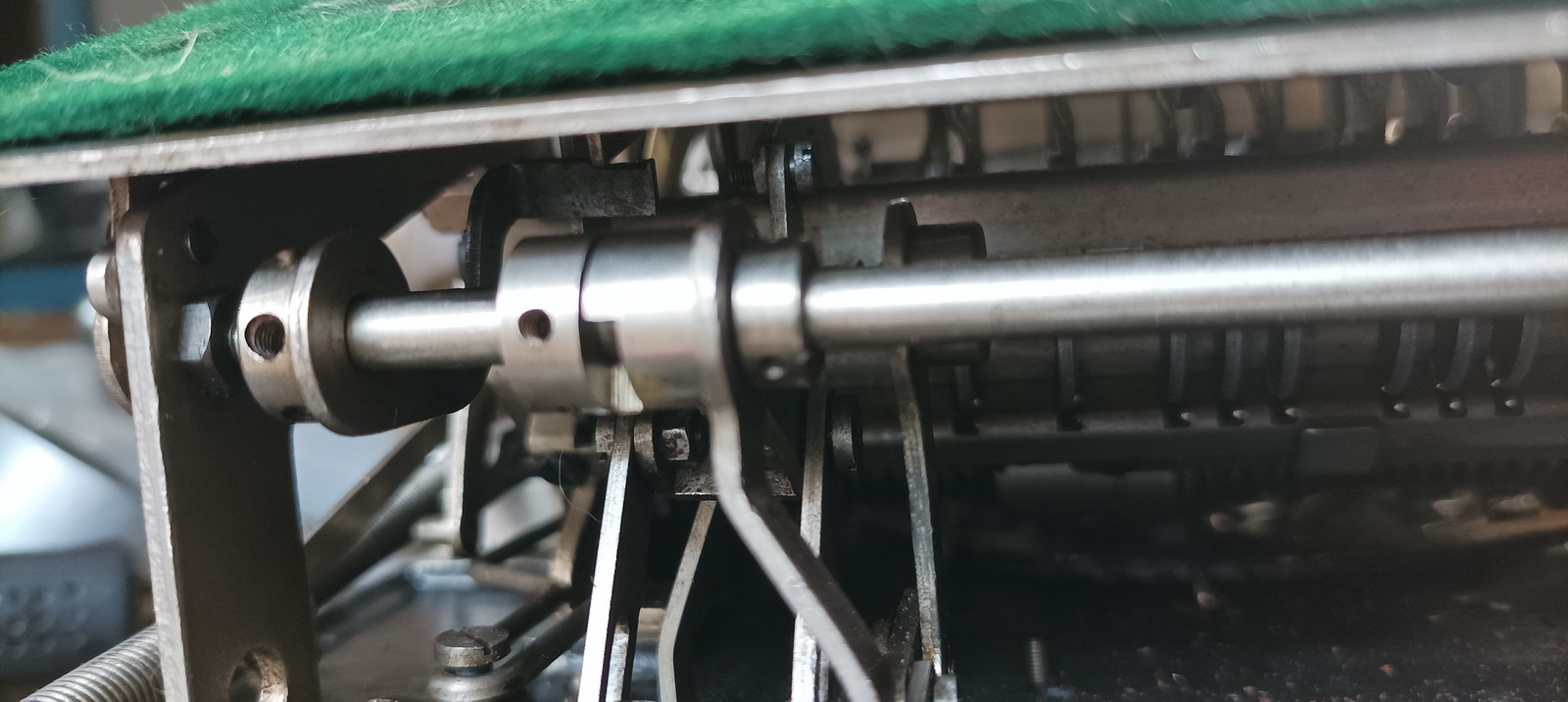
For the non-print key, all that was needed was a very slight tweak to the protrusion towards the key stem, visible in this picture. As you can tell, there already has been some grinding to bring it to the correct height, but it was sitting still ever so slightly too high. A slight bend fixed this. The lever is pinned to the rotating shaft in the front that eventually operates the sector.
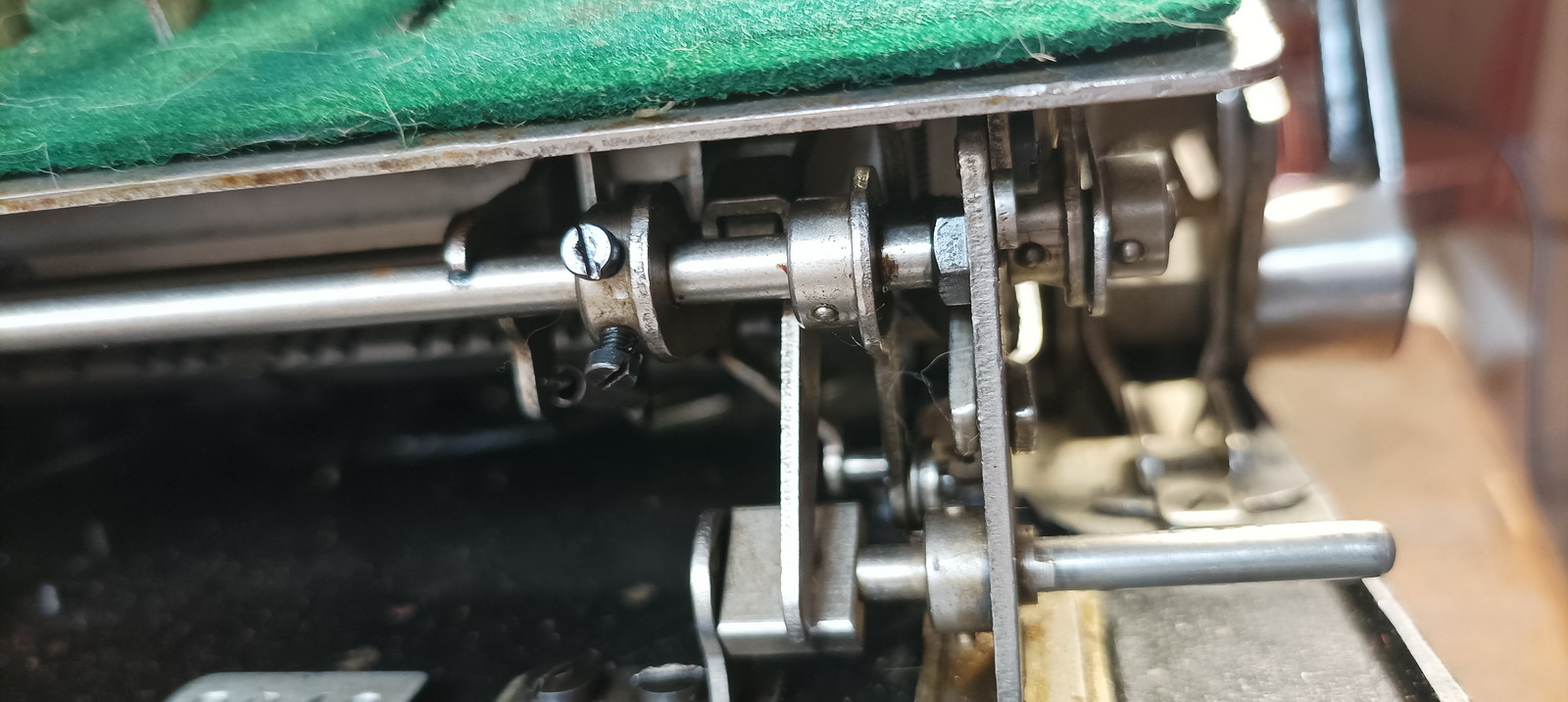
For the subtotal key, the lever is screwed to the shaft, so the two locking screws can be undone and an adjustment made. Job done!
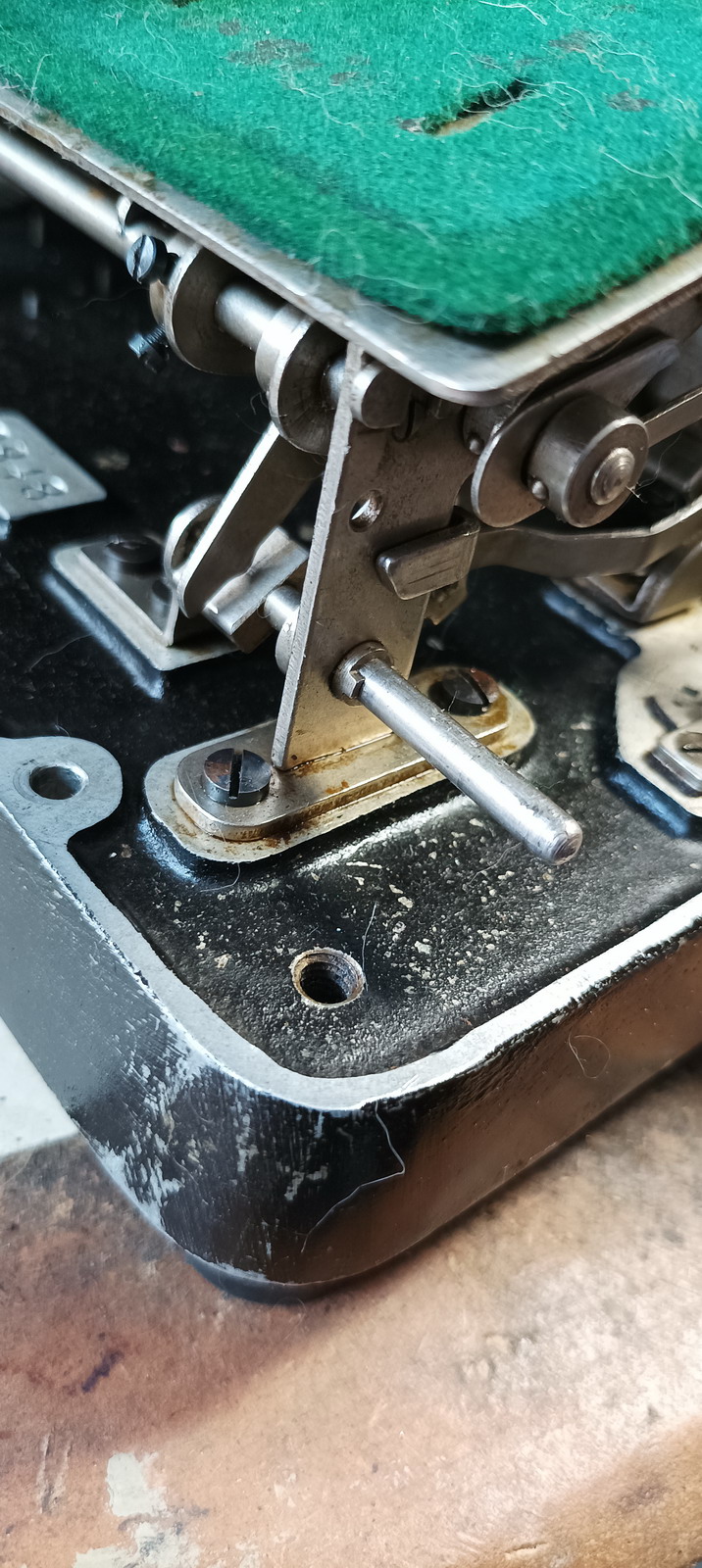
A final interesting feature of the Astra is that there is a small hole in the front right of the calculator - through this, the owner could fit a key, and with a twist of 90° could block the total, subtotal and non-add keys, rendering the machine unusable. I’m sure that had its use in some companies, to avoid doctoring the books after closing time ?
So finally, here are some pictures of the machine!
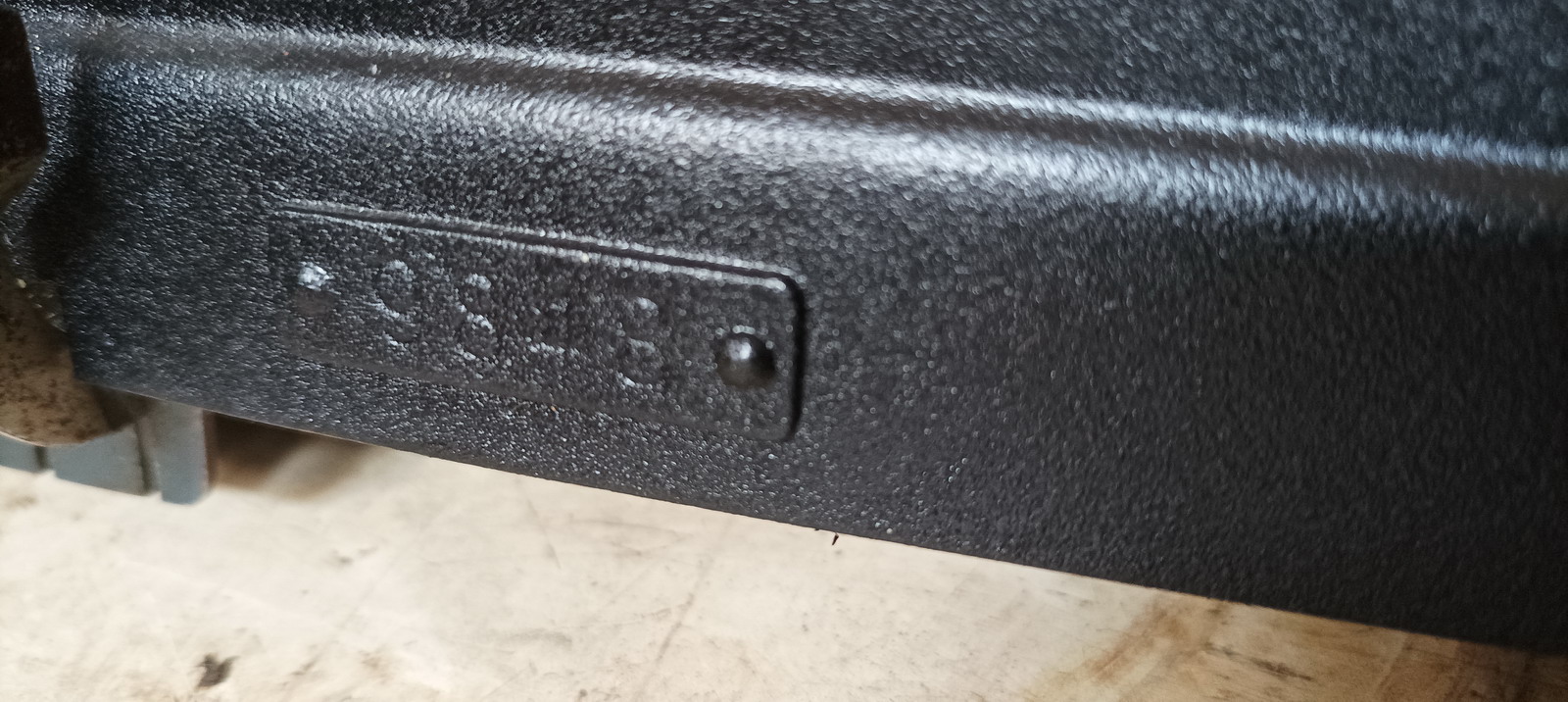
The serial number of the Astra - 9848. The housing and paper table of the machine have been recoated with crinkle paint somewhere during its lifetime.
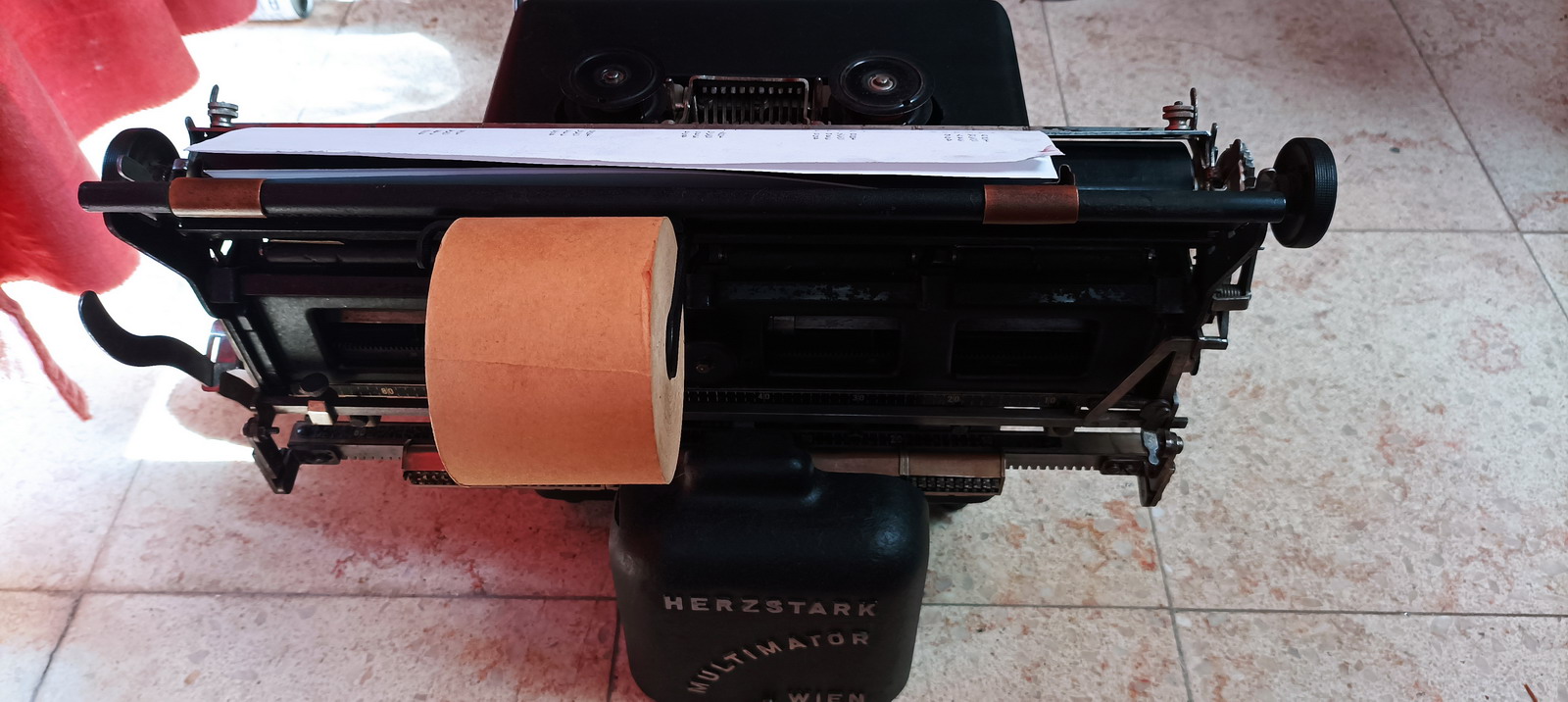
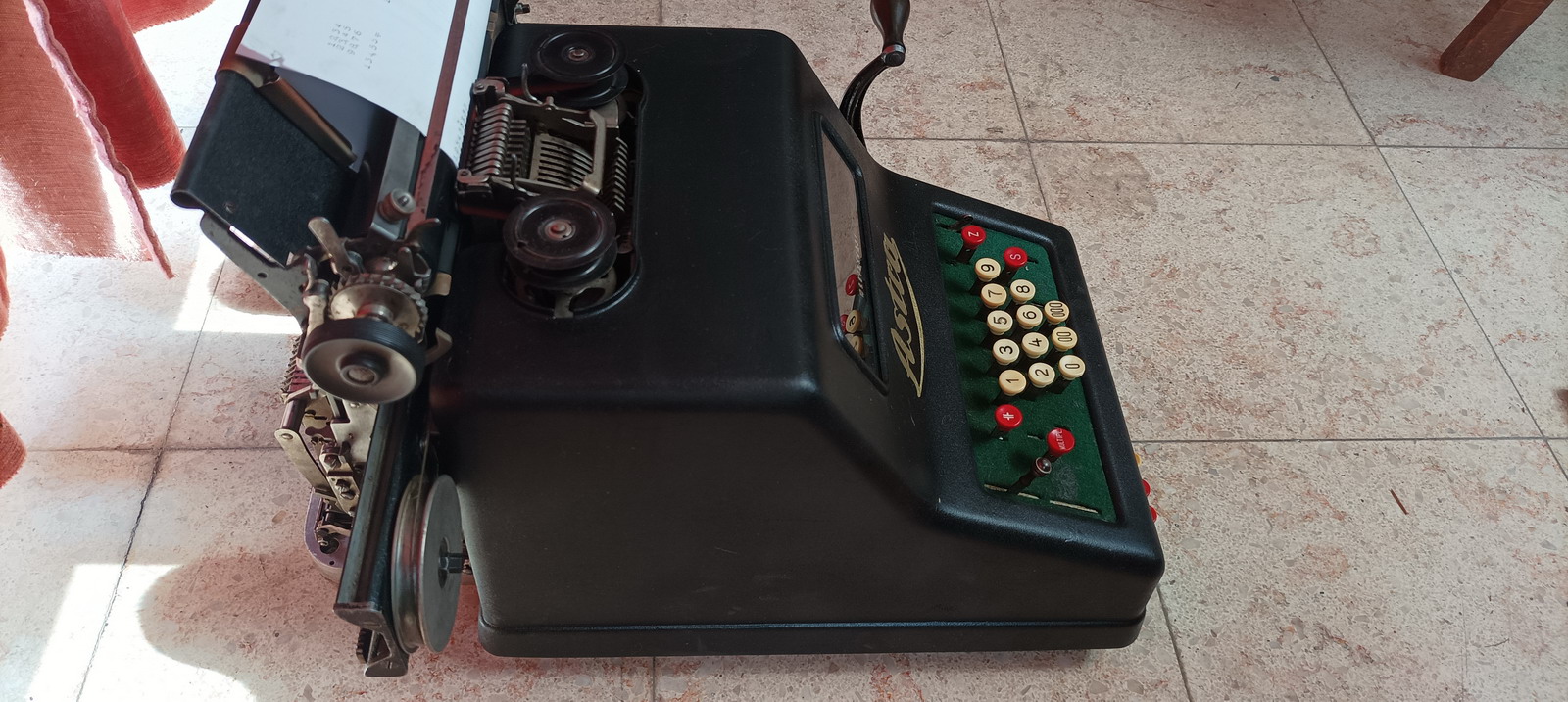
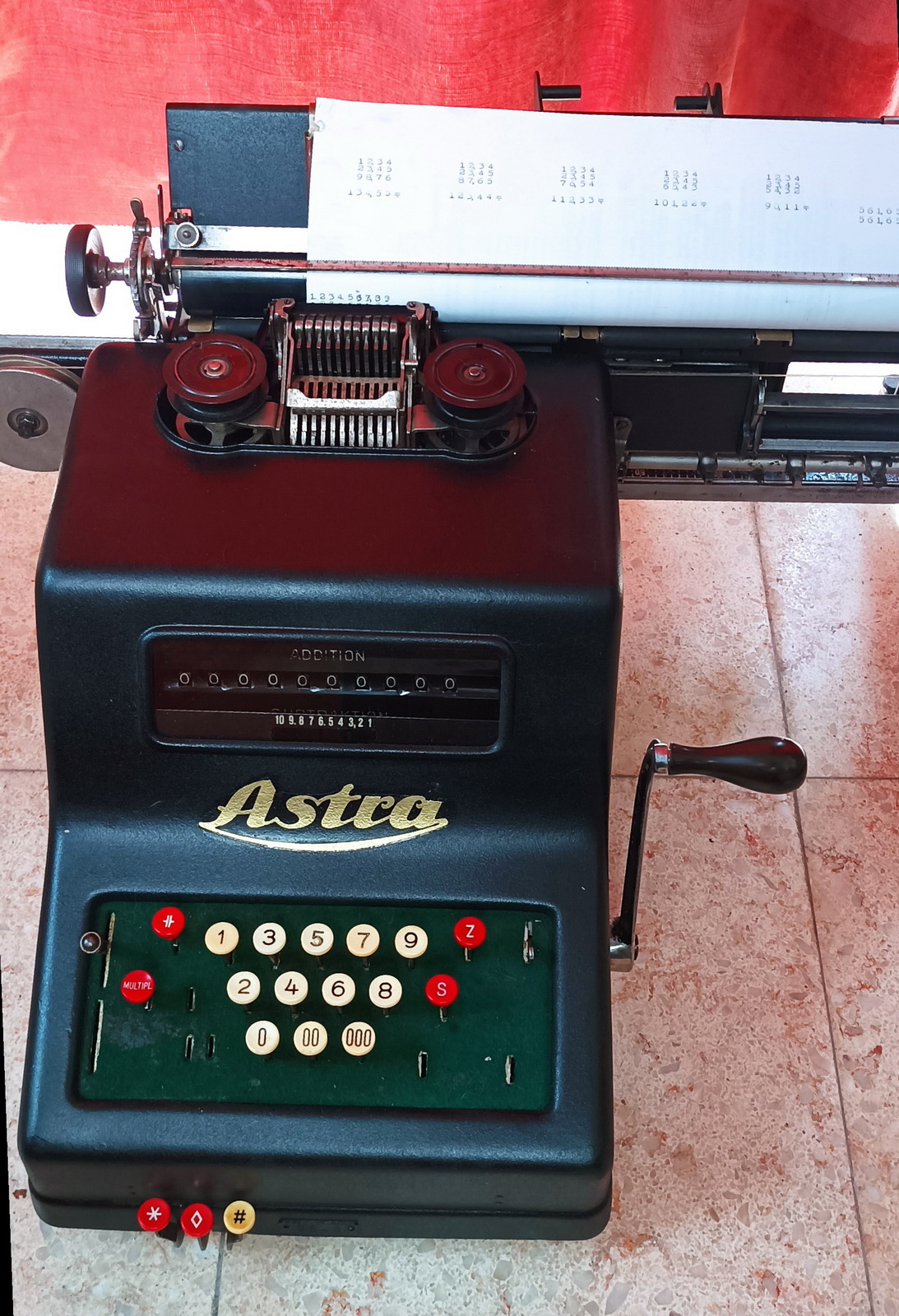
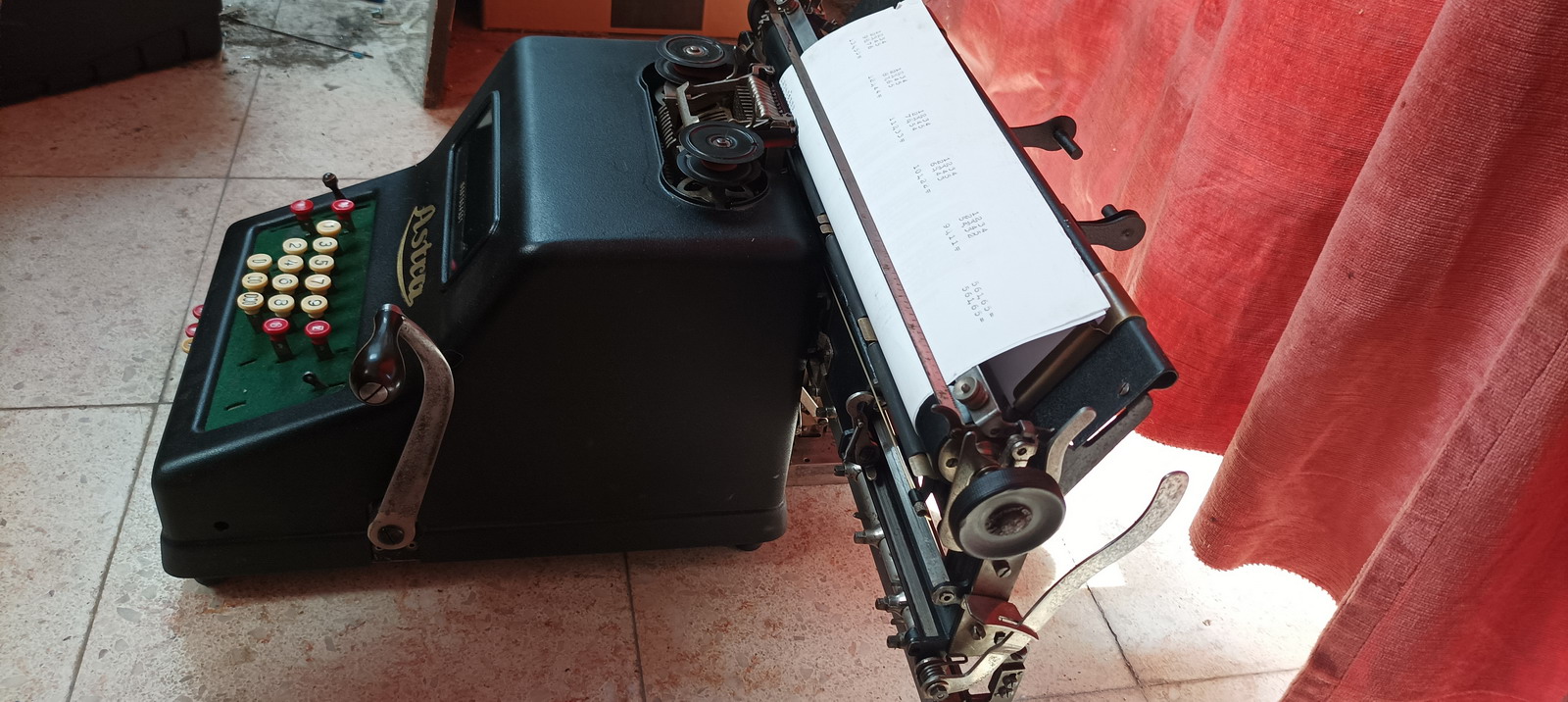
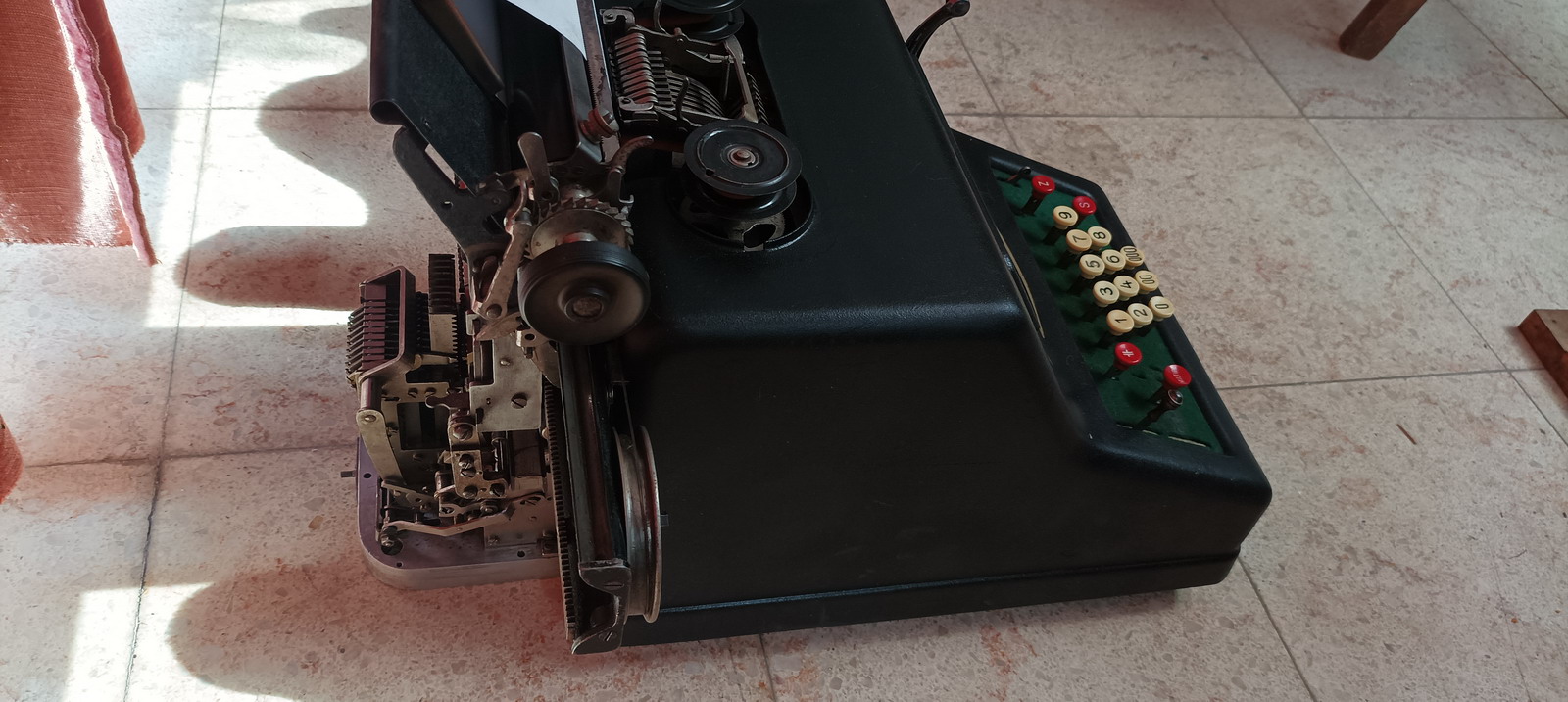
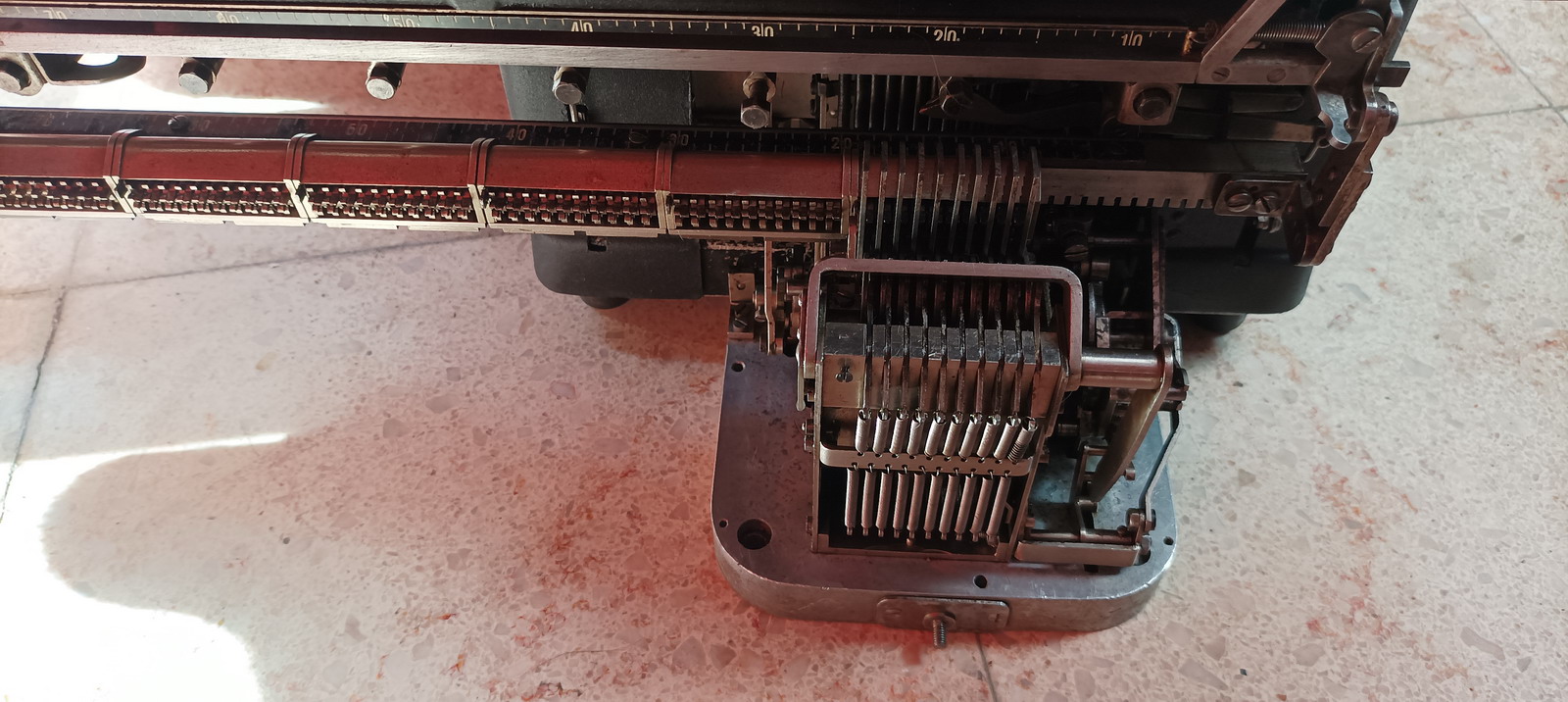
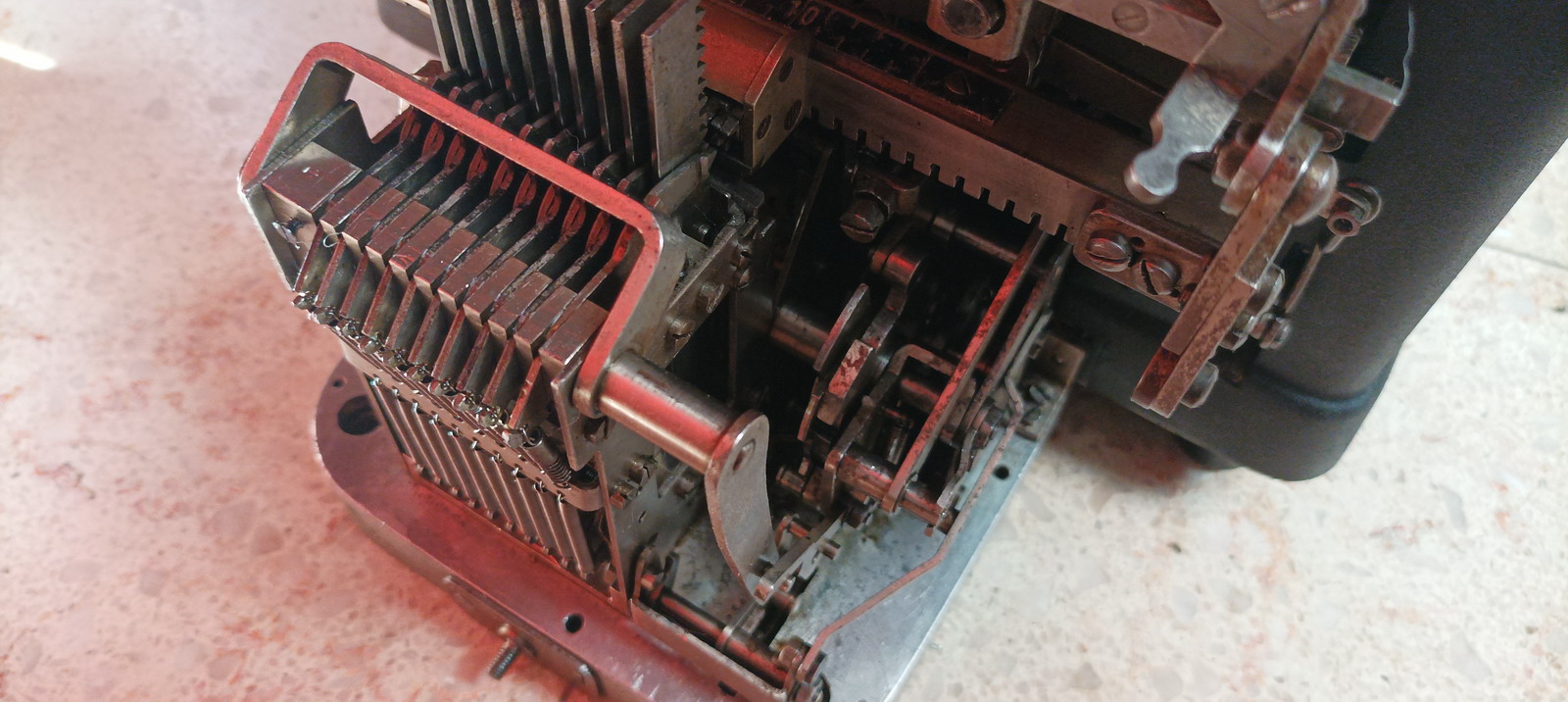
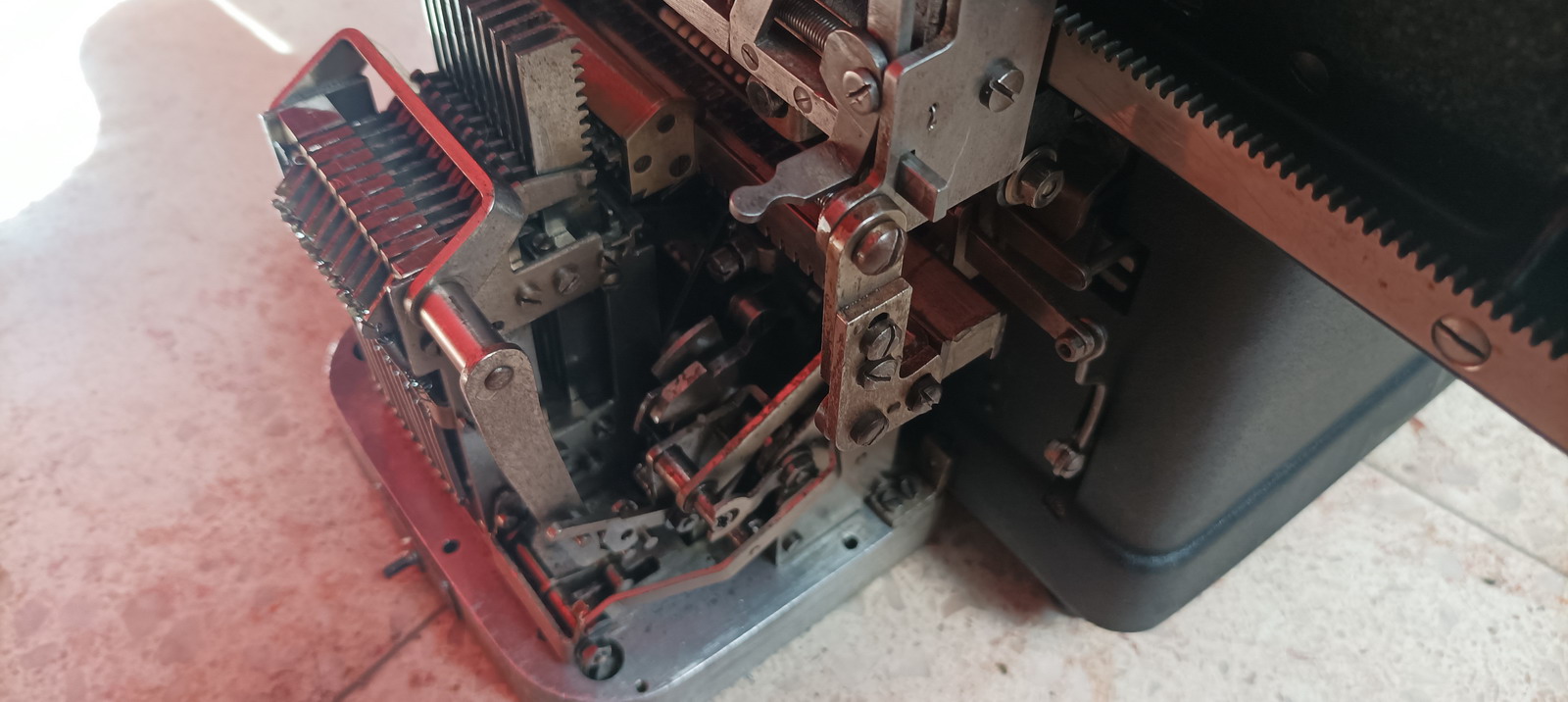

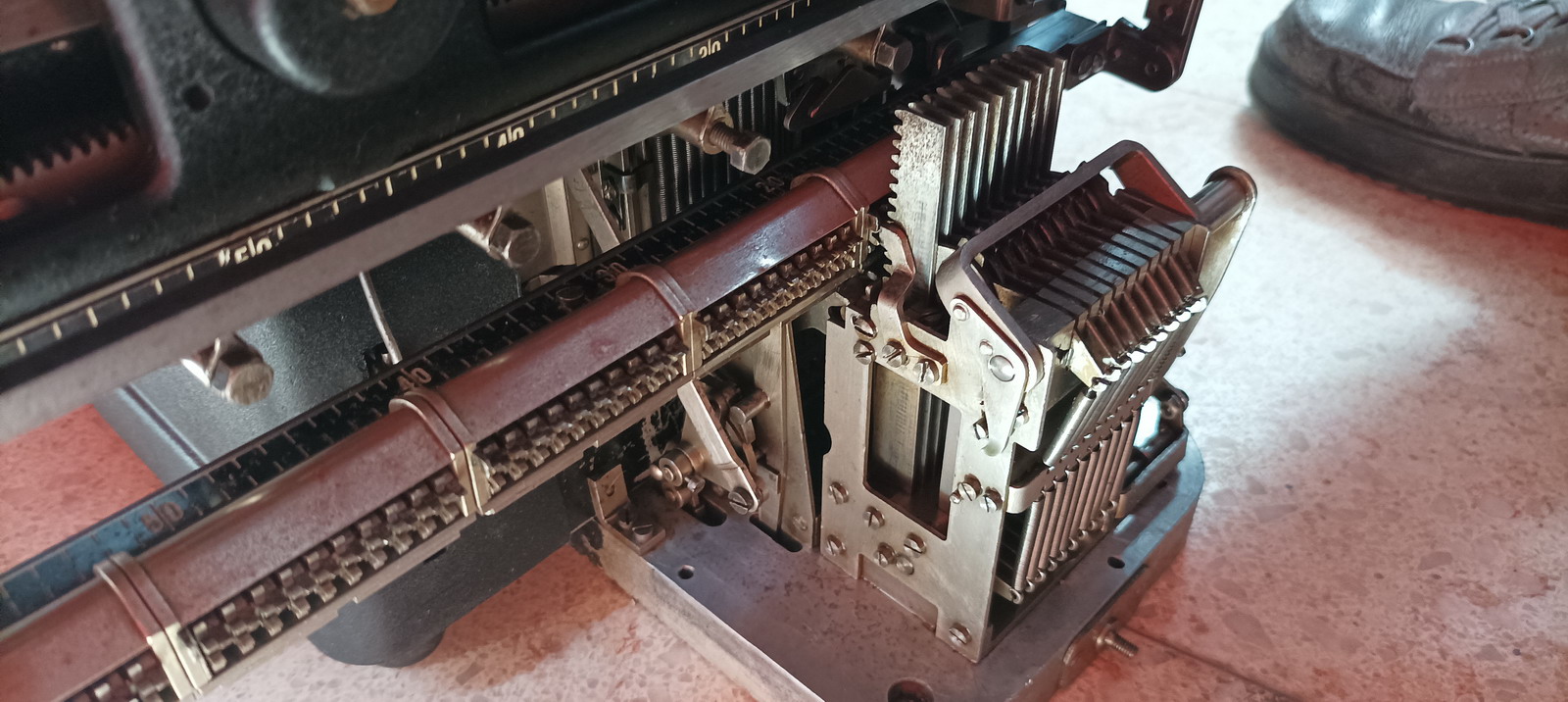
And finally an explanatory video:
